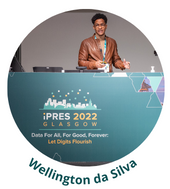 I discovered iPres in 2019 when I was looking for articles for my final master’s work. I found many good papers that helped me a lot. When I started searching for more about iPres and decided to participate in the next one, which would be in 2020, it didn’t happen because of the pandemic. However, I didn’t give up; I kept following on social media to keep updated. Participating in iPres meant acquiring more knowledge about digital preservation, to put it into practice in my job, and the result was better than expected.
I discovered iPres in 2019 when I was looking for articles for my final master’s work. I found many good papers that helped me a lot. When I started searching for more about iPres and decided to participate in the next one, which would be in 2020, it didn’t happen because of the pandemic. However, I didn’t give up; I kept following on social media to keep updated. Participating in iPres meant acquiring more knowledge about digital preservation, to put it into practice in my job, and the result was better than expected.
I am currently an archivist at the National Library of Brazil, working in records management and I am a member of the permanent commission for digital preservation. Since 2018, the production of digital documents has been growing in my institution, and has required acquiring more knowledge to preserve them. In addition, we have the largest digital library in Latin America, with 2,138,378 million documents. Attending this conference in 2022 helped me outline strategies, exchange experiences and ideas with professionals from four continents, to preserve all these digital documents.
In addition to participating as an attendee, I had the opportunity to be awarded a DPC bursary to present the final work of my Master of Public Policy: Why Digital Preservation Should be Treated as a Public Policy, in the Lighting Talks section. The desire to participate in iPres multiplied and I was able to contribute, to be on both sides, grateful of the recognition of the organizers for my work.
Lighting Talks is the ideal way for the first international presentation; it is an incredible experience to be at the biggest digital preservation event, presenting a work in another language. It is an experience which makes me want to improve more in the area of digital preservation, in order to contribute more for diffusion and adhesion.
The papers presented made me think and rethink about what digital preservation is. What needs to be done to preserve the digital materials that are being produced? How to decide what should be preserved? These were some questions that iPres made me reflect on. The keynote Tamar Evangelestia-Dougherty (Digital Ties That Bind: Effectively Engaging With Communities For Equitable Digital Preservation Ecosystems) was one of the keynotes that impressed me the most, it brought a perspective on digital preservation that I had never thought of that made me reflect that digital preservation goes beyond guaranteeing access to digital documents in the future, it guarantees the visibility of a people, their culture and customs.
The Tutorial: Continuous Improvement Tools for Developing Capacity and Skills on RAM and CAT was of paramount importance, as RAM allows assessing the institution and knowing their maturity stage. From this diagnosis, it is possible to outline a strategy for digital preservation. It is very important for the digital preservation community to have an institution like the DPC.
The Workshop: Changing Curriculums for a Changing World? Living in Interesting Times: Digital Preservation Education, Pedagogy and Skills, gave me the opportunity to learn about the training of future information professionals in Scotland, what they are studying now, what are the similarities and differences with Brazil.
When the event ended, it was like a movie playing in my head about everything I had seen, learned, absorbed, thinking about how to put it into practice, what I should do, what skills I already have, which ones I need to improve and which ones I lack? What should my institution do to preserve what has already been produced, what is being done and what will be, what are the gaps, who are the sponsors? All these issues were mentioned at some point in a lecture about the vision of that institution, which is very important to compare, to know where we are and where we want or can be.
I am very anxious to pass on everything I heard and learned to the preservation committee that I am part of, to convince them to be at the next events, perhaps presenting a paper about the National Library of Brazil, showing what our stage of maturity was before and after of iPres 2022. Which collections were invisible and are no longer, how to convince our sponsors, are ideas which have started to boil in my mind after iPres 2022, ideas that makes me want to do something for my institution, and share with many others to allow that they do too and learn from them too, because digital preservation is not done alone.
My conclusion about iPres is to do it together, to share what we know, because we are all with the same goal and moving in the same direction. I hope to be present at all iPres and I will do my best to get more Brazilians to be too, because iPres encourages me to go further, encourages me to want to do and share!
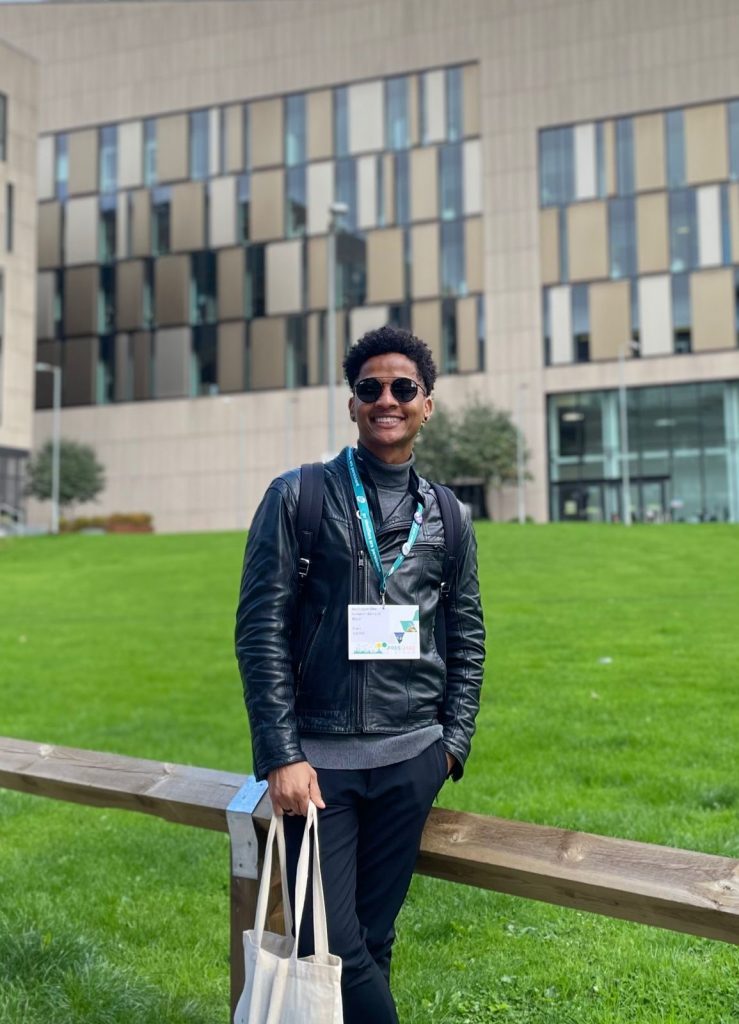
Great panels, inspirational sessions, thought-provoking keynotes and a great digipres crowd. Looking back at iPres 2022 leaves us with nothing but good memories. In this blogpost you’ll read which highlights some of the iPres 2022 delegates took back home with them.
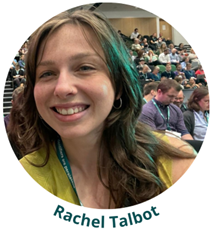
Having been introduced to the world of Digital Preservation through my MSc at the University of Glasgow while also being six months into my first post-graduate role in Information Management in Edinburgh, it felt like the stars had aligned that iPres2022 was being held a train-ride away, in Glasgow.
Through my role as Data Steward at the National Geoscience Data Centre (NGDC) within the British Geological Survey, I was graciously able to access a DPC-member supported registration through UKRI, our main funding body. An opportunity I was extremely grateful for.
Through iPres2022 I have found, at this early point in my career, the invigorating and inspiring effect of a gathering of like-minded, passionate people pathing the way at conferences. No more was this relevant than when I attended the long paper presentation, Green Goes with Anything: Decreasing Environmental Impact of Digital Libraries at Virginia Tech by Alex Kinnaman, Digital Preservation Coordinator at the Virginia Tech University Libraries.
I have learnt through benchmarking with the DPC RAM tool early in the year, that the NGDC is at the start of its digital preservation implementation journey. However, by observing the changes in documentation and practice that Virginia Tech had implemented in their library to develop a more environmentally sustainable platform, I was able to see which processes we could consider right from the offset as we develop our programme. Most notably, as we iron out the details of embedding the TurboSFV tool into our workflow, how reduced fixity checks and an increase of spot-checking files and file restorations, could mean that we save energy from the very start. An attractive goal, as we look towards a more sustainable future in the sector.
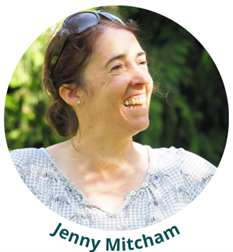 One of my iPres highlights has to be the Great Digital Preservation Bake Off! I had been roped into being one of the judges for two out of the three Bake Off sessions which ran on the Wednesday. I hadn’t known quite what to expect but left the sessions both enlightened and entertained.
One of my iPres highlights has to be the Great Digital Preservation Bake Off! I had been roped into being one of the judges for two out of the three Bake Off sessions which ran on the Wednesday. I hadn’t known quite what to expect but left the sessions both enlightened and entertained.
The sessions saw perhaps as many as 15 different tools being demonstrated in snappy and good humoured, ten minute presentations (and sometimes even live demos!) and we saw a good mixture of systems and tools – both those that carry out a very specific task in the digital preservation workflow and full digital preservation systems.
A couple of observations, coming out of these sessions – first, how amazing it is that the community has so many enthusiastic individuals who are prepared to create and maintain tools which are free for others to use; second, how nice it is to see tools building on and reusing the outputs of other tools.
This seems like a healthy ecosystem, but one of the points raised on the day was how can we better support open source tools in this community. So many of these rely on the good will and vision of a few talented and enthusiastic individuals, but is this sustainable? Overall a really enjoyable session (and of course the large quantities of cake also helped).
 iPres 2022 in Glasgow was my first in-person conference in three years, and the first iPRES conference I had attended in person. It was an excellent opportunity to finally meet people whom I up till then had only seen virtually. I also made some new friends after chance encounters during lunch – not something that happens easily online.
iPres 2022 in Glasgow was my first in-person conference in three years, and the first iPRES conference I had attended in person. It was an excellent opportunity to finally meet people whom I up till then had only seen virtually. I also made some new friends after chance encounters during lunch – not something that happens easily online.
The conference was full of “aha” or “hmm” moments for me. One of these came during the tutorial on “Mitigating Risk and Building Cyber Resilience in the Age of Ransomware”. Several participants highlighted the potential for synergy and cooperation between digital preservationists and cybersecurity professionals, because we both think about data in similar ways, and share similar concerns about how data is treated. For example, we both care about the integrity of data, and the availability of data, even if we sometimes use different terms to talk about these concepts. I had noticed some of these similarities before, when speaking to our own cybersecurity colleagues, but never connected the dots and seen them as an opportunity.
Another memorable moment for me was during the “Innovation 1” panel on computational access to digital material. One of the several topics raised was obstacles to access, as an alternative to no access at all. On the one hand, introducing some friction to digital access, for example adding further steps or conditions to access, could swing the risk calculation towards allowing greater access to more content. On the other hand, too much friction, or the wrong kind of friction, could introduce biases to access, or be seen as running counter to an organization’s core aims. One participant noted that the right kind of friction could be unintentionally beneficial, serving as a memory aid, helping users recall the content they are viewing, or recall certain facts about the content they are viewing. An example could be requiring the user to acknowledge that some content was produced in a certain context and some years ago, before allowing them to view it. These are definitely things to think more about.
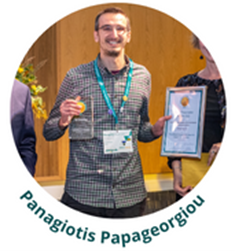 Immediately after the full iPres 2022 schedule was revealed, I circled quite a few sessions that I knew that I did not want to miss. As anticipated, I walked out of the Technology and Innovation Centre with a new perspective on things that I already knew, as well as new valuable knowledge. But what really has stuck in my memory are the many entertaining game (analogue and digital) sessions which were offered by enthusiastic and extremely knowledgeable professionals.
Immediately after the full iPres 2022 schedule was revealed, I circled quite a few sessions that I knew that I did not want to miss. As anticipated, I walked out of the Technology and Innovation Centre with a new perspective on things that I already knew, as well as new valuable knowledge. But what really has stuck in my memory are the many entertaining game (analogue and digital) sessions which were offered by enthusiastic and extremely knowledgeable professionals.
Initially, the board game designed by Eld Zierau and Sibyl Schaefer had me and the rest of the players longing to discover what our final board would look like, while Simon Tanner’s thought game entitled ‘Grapes, Wine, Bottle and Drinking’ truly impressed me with its perfect analogy: What a tangible way for everybody to grasp, and potentially reconsider our views about, important digital preservation concepts!
To my delight, I received the Research and Innovation Award (sponsored by the Software Sustainability Institute) for my PhD programme during iPres 2022, and I was also fortunate enough to meet new members, as well as catch up with old acquaintances, of the amazing global digital preservation community.
All in all, I have definitely broadened my horizons through all those various ‘Inform-Educate-Entertain’ (to borrow the title of the first Public Service Broadcasting album) moments.
Read Panos’ full blogpost ‘Up to the RIM (Ripe iPres Memories), please!’ posted here below:
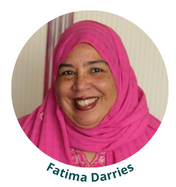 iPres 2022 is the 18th International Conference on Digital Preservation and was held from 12-16 September 2022. My virtual attendance was supported by the Digital Preservation Coalition sponsorship for member institutions.
iPres 2022 is the 18th International Conference on Digital Preservation and was held from 12-16 September 2022. My virtual attendance was supported by the Digital Preservation Coalition sponsorship for member institutions.
The conference organising committee did a fantastic job and set the standards high for subsequent conferences. Before the conference even started, I received an email with information on online attendance and the iPres 2022 Glasgow app. The conference app was very useful. Access to the web cast was on the Zoom platform, but the app was my point of access of choice for checking the programme, identifying the networking sessions for virtual attendees, information on the sessions and authors, and quick access to the abstract.
I appreciated the networking sessions for the virtual attendees. I was joining in from Pretoria in South Africa with an hour time difference, other virtual attendees were joining from places around the globe with much bigger time differences. The discussion in the room on strategies to cope settled on popcorn and coffee.
The sunrise sessions were particularly useful to catch up with parallel sessions, and ‘not to be missed’ papers. I am particularly impressed with William Kilbride who joined the sessions from early in the morning, before leaving for the conference venue.
Robin Wright also joined the Sunrise session and hosted the iPres radio with half hour open zoom sessions. Although I did not manage to join the iPres radio sessions, it’s a fantastic way for virtual attendees to engage on the happenings mid-way through the day. See Robin Wrights’ blog post for more.
One of the benefits of hybrid conferences is that sessions are recorded. So, deciding between parallel sessions was a bit easier because the recording can be accessed for the ones missed out on. It is also a fantastic way to take the conference back home. We shared ideas on watch parties especially for the keynote addresses.
The three keynote speeches across the week of the conference were kicked off by Amina Shah, National Library of Scotland, whose address was titled ‘Video Killed the Radio Star: preserving a nation’s memory’. That song is now forever the soundtrack for iPres 2022 in my memory. Resonating with me, was Amina’s reminder on the need for resilience in changing times, and quotes that I take way “Content nowadays is not just born digital, but born fragile” and “How do you deal with constant change? You hire amazing staff!”
Tamara Evangelestia-Dougherty, Director of Smithsonian Libraries and Museums, delivered an electrifying 2nd keynote. She spoke convincingly on working with community archives and museums, working collaboratively so that community archivists also benefit.
And finally, Steven Gonzalez Monserrate, Cloud Anthropologist, spoke on the impact of data centers on the environment. The storage infrastructures that we all use for digital preservation contribute to climate change, desertification, noise pollution, and the proliferation of toxic e-waste. His address was stunning and left everyone speechless.
I cannot possibly do justice to the keynotes, and I encourage you to watch the recordings when they become available and have your own watch parties.
Another way to engage with what was happening at the conference are Tweets from other conference attendees whether virtual or in ‘3D’ person. The Twitter handle for the conference was #ipres2022. For the purposes of this blog, I want to point to the takeaway Tweets of Valerie Love @valerielovenz on capturing ideas for discussion and implement at your home institution, and Steven Gonzalez Monserrate @cloudAnthro, for a reflective view of the conference from outside of the preservation community.
Also to be found in the Twitter posts is conference fashion. You will see the kilts, the shoes and the knitted sweaters.
William Kilbride asked us to light up Twitter with the DPC Awards. Wow, what an exciting evening to watch but more so for the nominees and finalists. The DPC awards ceremony was held on the first night of the conference and there were 8 awards with a special 20th anniversary award from the DPC. Lots of pictures and comments on Twitter about this and also the evening’s recording has been published on the DPC Youtube channel, and all the stories of the wonderful work being done can be found on the website.
It was a busy conference both in person and virtually. Those who attended virtually missed out on the birthday cake, tartan scarves and other conference goodies, but had the benefit of sleeping in their own beds, not having to deal with weather and train schedules!
However, nothing competes with attending a conference in person and connecting with people who share the same passions and concerns, so start planning your iPres2023 attendance in Urbana-Champaign in Illinois, U.S.A., September 19 – 22, 2023.
This blog was written for you by Fatima Darries (University of South Africa)

Personal archival photograph taken at Café W (Waterstones), Portsmouth
My iPres journey started, at least, three months before the actual event. The moment this year’s Digital Preservation Awards finalists were announced, I knew deep inside, that no matter what, I had to make it to Glasgow. Firstly, because I was curious to find out if I was going to win, and secondly because I was determined to spearhead my academic career through, the ever so important, networking. Not to mention the chance of visiting Glasgow for the first time, and attending some really interesting sessions.
Four out of four! To my delight, I received the Research and Innovation Award (sponsored by the Software Sustainability Institute) for my PhD programme, and I was also fortunate enough to meet new members, as well as catch up with old acquaintances, of the amazing global digital preservation community.
Thanks to two generous career development grants funded by the Digital Preservation Coalition, I managed to attend all five days of the eighteenth edition of the International Conference on Digital Preservation (iPres), and experience some of Glasgow’s top sights, such as the architecturally unique Riverside Museum.
Immediately after the full iPres 2022 schedule was revealed, I circled quite a few sessions that I knew that I did not want to miss. As it was anticipated, I was walking out of the rooms of the Technology and Innovation Centre gaining a new perspective for things that I already knew, as well as new valuable knowledge. But what really has stuck in my memory are the many entertaining game (analogue and digital) sessions which were offered by enthusiastic and extremely knowledgeable professionals.
Initially, the board game designed by Eld Zierau and Sibyl Schaefer had me and the rest of the players longing to discover how our final board would look like, while Simon Tanner’s thought game entitled ‘Grapes, Wine, Bottle and Drinking’ truly impressed me with its perfect analogy: What a tangible way for everybody to grasp, and potentially reconsider our views about, important digital preservation concepts!

Personal archival photograph of ‘The Preservation Storage Criteria Game’
All in all, I have definitely broadened my horizons through all those various ‘Inform-Educate-Entertain’ (to borrow the title of the first Public Service Broadcasting album) moments.
P.S: I am currently training to reach the top of the leaderboard in Giulia Carla Rossi’s ‘The Digital Archivist: a video game.
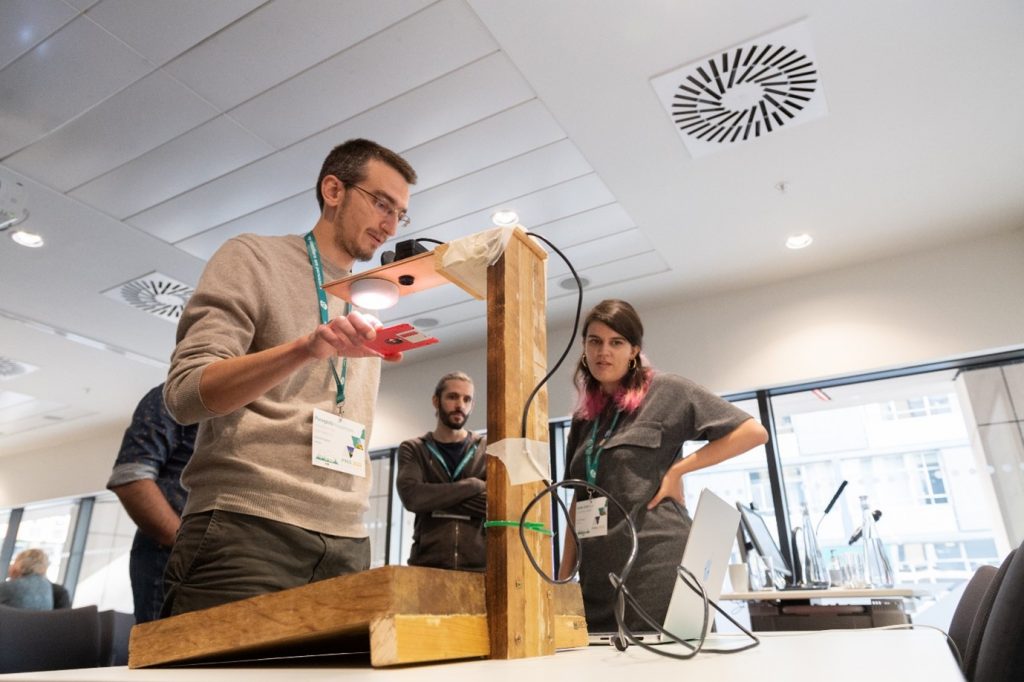
This blog was written for you by Panagiotis Papageorgiou (University of Portsmouth)
It’s a strange place to start a blog about iPres but it came to me while I was driving home from the conference on Friday. iPres 2022 started with an email exchange in the first week of March 2017: five and half years in planning and less than five days in delivery. I have common cause this week with the astonished residents of Oban. What on Earth has just happened?
Fractal Paths
If I could offer one message about conference planning it would be to understand that it’s entirely not a linear process. It’s more like a fractal drift where every single decision creates an infinite regression of smaller ones. You go round and round and round till you either run out of time or energy or both.
The best example is the call for contributions which (in our case) opened the floodgates of proposals and suggestions. Of course you then need to assign reviewers; and decide how they will do the review; and review the review criteria; and decide whether you agree with the review outcomes; and then how to communicate the review; and whether review actions have been followed etc.
That’s just one obvious case study but it’s true of every single decision you make. Sometimes you know even from the outset (no bagpipes indoors); sometimes you get to the details just in the nick of time (those lovely pictures on the draft marketing materials, you know that’s Edinburgh right?); sometimes you can make a virtue of it (well if you can’t do more scarves in time can you do ties or hip flasks?); and sometimes with the best will in the world, the details evade you (yes the cupcakes were colour-coded vegan and gluten-free alternatives but we completely forgot to tell anyone). Sometimes it’s just too late (I’ve completely run out of time to give any meaningful closing remarks, so here’s some music instead); or you just can’t process any more (I’m refusing to take a view on which particular shade of green the volunteer hoodies should be). But every single decision creates more decisions.
 Photo by Roberto Ricciuti – Mint green volunteer hoodies
Photo by Roberto Ricciuti – Mint green volunteer hoodiesWhat delegates experience is the great heap of small decisions informed by the insight and ambition and rush and luck and flaw and humour and humanity and values and budget and expediency which swirl around them.
Here are some of the decisions which I think we got right:
- Do what we said we’d do: we made a determined effort to stick to all our deadlines so there was no doubt that iPres would go ahead. The UK has had three governments since 2017, and we launched the conference in a pandemic. The call for contributions was just closing as a land war broke out in Europe. A little confidence is needed against these odds. The call for contributions closed at the advertised date (a few late entries took advantage of our offer of alerting us that a late submission was imminent, but there was no extension to the deadline); and the conference dates, 12-16th September were exactly those proposed in 2017.
- Environment: I think 2022 was the first iPres to have a policy to remove, reduce or offset environmental damage. There’s also an assessment framework to help us measure the impact and help future hosts understand this element. There was no conference pack at all.
- Hybrid: we webcast two streams from the venue, hosted a third stream entirely online, and recorded a fourth. This is a hugely expensive undertaking but we hope will be incredibly valuable in the long run as well as in the present.
- Red Carpet, Sunrise and Late Show session: we wanted the online conference experience to be more than simply a series of presentations, so attempted to draw online delegates into the venue with short informal programming with in-person delegates.
- New entrants in the program committee: We invited a very large program committee, explicitly with people who had not served on a program committee before. They will be the next generation of leaders in our community and I look forward to the many wonderful conferences which they will organize.
- Welcome and inclusion from the outset: we were explicit that the conference policy of welcome and inclusion started at the very beginning. Reviewers were briefed that every contributor should have a positive experience even if their contribution was not accepted.
- Single platform: we used a single platform from abstract management through to registration, and to populate the conference app. In doing so we moved iPres away from EasyChair whose integration with other systems and data protection policies seem antiquated.
- Local Legacy: we wanted to make sure that agencies in Scotland could take advantage of the presence of so much professional expertise in the country. That was the origin of the professional visit program on Friday and exceeded our expectations.
Here, in contrast, are some of the hopes that never got off the ground but which I think are worth exploring
- Simultaneous translation: the hybrid platform allows simultaneous translation. We experimented with different options here but the demand didn’t seem to justify the expense at this time. But if iPres is really an international conference then this will need to be developed further.
- Child friendly: we wanted to provide some capacity for childcare at or around the conference venue, such as a nursery. This request seemed to surprise the venue and our professional conference organizers and is not standard. The cost was significantly more than we could justify but again if iPres is to be an accessible conference this seems non-trivial.
- Public program: we had hoped to have a public program for iPres to engage a wider public. We identified this as a ‘nice to have’ in case the conference found itself in significant surplus but the costs of the hybrid platform meant the conference only began to break even too late to be able to do much in the public domain.
- Children’s take over: we had an idea that iPres has never yet consulted the next generation about what they would like to preserve. We consulted with colleagues in a number of school and educational bodies in the city to see if we could engineer a sort of young-person’s takeover day so that the next generation was very obviously present. It was just too much of a stretch to do that, but still worth trying.
My highlight? I think I only made four actual papers at the conference so I think I can be excused from being specific; but also that would be invidious. So for me the most satisfying moment was standing back and seeing the seemingly infinite regression of details coalescing to create the whole picture, not as a plan but a lived experience.
 The iPres 2022 conference theme on the lectern boards
The iPres 2022 conference theme on the lectern boardsI remember an early discussion about conference themes. We had adapted the theme ‘Let Digits Flourish’ from Glasgow city’s own motto ‘Let Glasgow Flourish,’ which caused a brief discussion of the other elements of the city’s coat of arms, including the little bird which sits in the tree. It’s always a small bird – a robin or a sparrow or a starling and I remember one keen birdwatcher on the DPC staff being unimpressed that it wasn’t some great imperial eagle or wise old owl. That memory returned to me as I passed the amazing mural on High Street close to the venue on the first day. The bird is supposed to be small. It derives from the legend of the city’s founder Saint Kentigern more generally known as ‘Mungo’ a name which means ‘the big man’. He is credited with restoring to life a small bird which had been killed through some rough and tumble play of school mates. It’s an allegory: you can only become the ‘big man’ if you pay close attention to the small things.

Photo by Sharon McMeekin – St. Mungo mural in Glasgow
So it’s time to call out the names of all friends and colleagues who have earned and shared that title this week.
Looking back at my notes from March 2017 I was both sceptical about our capacity to deliver the conference and the interest of colleagues to support it. In one message to our partners in the City convention bureau I said ‘it’s probably 80:20 against doing this but the key people are not available to me just now: their enthusiasm or otherwise will be decisive for me.’ The seeds of the whole conference and its success are folded into that one short clause at the end. The enthusiasm of key people has been completely decisive. The great and welcome surprise has been the sheer number of people and the massive amount of enthusiasm they have brought. That has made all the difference.
As the posters around Glasgow almost say: People make iPres
 Photo credits: Glasgow Convention Bureau
Photo credits: Glasgow Convention Bureau
William Kilbride
Executive Director of the Digital Preservation Coalition
and Chair of the iPres 2022 Organizing Committee
Now that the final program has been released, it’s time to make choices which sessions you want to attend during iPres 2022. With amazing sessions on the 4-day program, those choices will be tough! We’ve asked the DPC team about their favourite sessions. This is what they are looking forward to mostly (but had a hard time deciding!):
1. Jenny Mitcham’s Favourite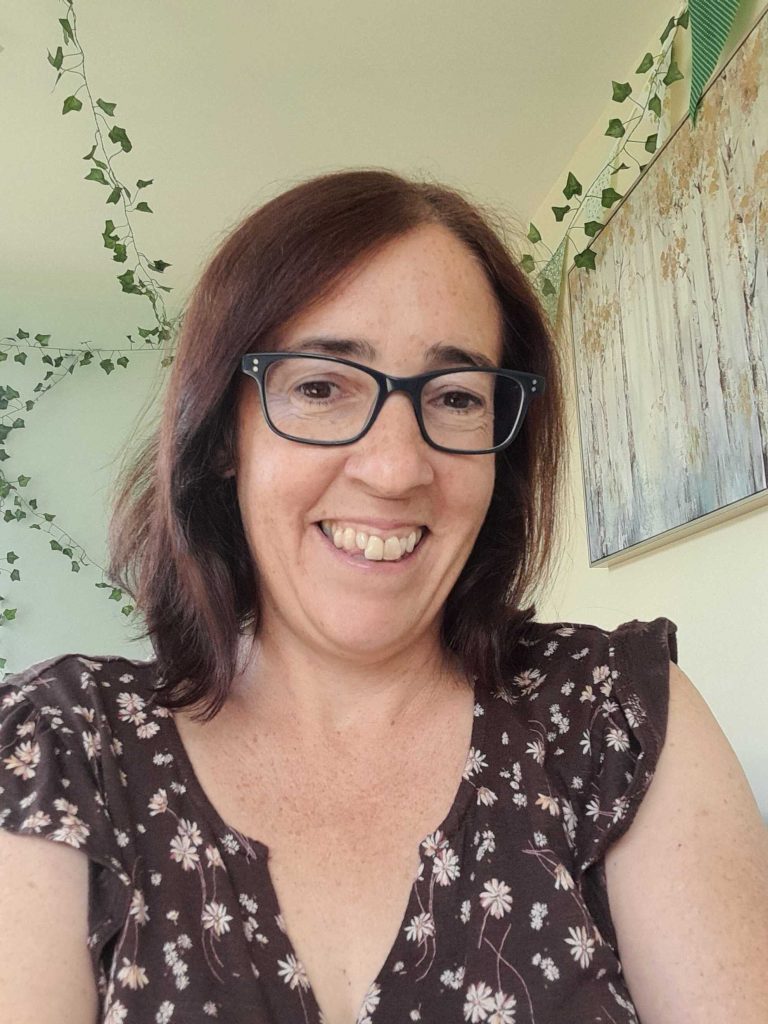 “Perhaps an unusual choice, but the part of the conference programme I’m most looking forward to this year is the Digital Preservation Games sessions. There are several of these dotted throughout the programme and you will definitely find me at least one of them. Why have I chosen this? Well I love playing games and it is fun to see how community members have made the topic of digital preservation even more fun than it already is. But also, it is a great chance to network and interact with people informally face-to-face and have a bit of fun and this has been the sort of activity that has been harder to replicate online over the last couple of years. Who wouldn’t want to have a go at ‘Digital Preservation Jeopardy’ or a ‘Data Horror Escape Room’? Hope to see some of you there (and I promise not to get too competitive!)”
“Perhaps an unusual choice, but the part of the conference programme I’m most looking forward to this year is the Digital Preservation Games sessions. There are several of these dotted throughout the programme and you will definitely find me at least one of them. Why have I chosen this? Well I love playing games and it is fun to see how community members have made the topic of digital preservation even more fun than it already is. But also, it is a great chance to network and interact with people informally face-to-face and have a bit of fun and this has been the sort of activity that has been harder to replicate online over the last couple of years. Who wouldn’t want to have a go at ‘Digital Preservation Jeopardy’ or a ‘Data Horror Escape Room’? Hope to see some of you there (and I promise not to get too competitive!)”
2. Sarah Middleton’s Favourite
 Community 5 on Wednesday – Panel: A Labor of Language: Building The Global Preservation Community Through Funded Translation Projects
Community 5 on Wednesday – Panel: A Labor of Language: Building The Global Preservation Community Through Funded Translation Projects
“I’m currently learning Spanish and have even given a few digital preservation presentations in the language (although I have a long way to go before I’m proficient!) so anything to do with languages gets my vote straight away. But it also ties in with work we are doing to translate DPC resources to make those accessible to as wide an international audience as possible. So, I am SUPER interested to hear what this panel has to say.”
3. Paul Wheatley’s Favourite “The parallel question to ‘which conference session would you not want to miss for the world’ is of course prompted by the down to earth reality of parallel streams and the inevitability of the dreaded session clash. However hard conference organizers work to theme up sessions and avoid obvious clashing topics, you’re guaranteed at some point to hit that agonizing question of choosing between two particularly desirable subjects. Or even worse, it’s that sinking feeling when you realise the session you really wanted to hear clashes with a presentation you’re supposed to be giving elsewhere at the same time. And that’s what immediately springs to mind for me. On Monday I’ll be running a workshop on digital preservation registries. I’m really looking forward to coming together with colleagues to talk about our registry landscape and look at where we go next. And this is an excuse to give that session a plug! But (shhh don’t tell my fellow registry workshop organizers) I’d secretly love to be next door in a session run by Sara Day Thomson, Caylin Smith and Patricia Falcao who are workshopping an exploration into complex digital objects. There will be a chance to test the concept of applying a practical and minimal preservation approach not to simple or uniform content but to complex or interactive digital objects. It’s in part based on musings from Tim Gollins, Matthew Addis and myself (as well as a host of others) and our skepticism of speculative preservation action. In a world of limited resources, we argue that we should not be taking on predictive activities, but targeting our limited effort carefully. But does a minimal approach stand up when you’re looking at complex digital artworks, or interactive media or databases? This sounds to me like a great opportunity to explore some challenging preservation questions with a bunch of lovely iPRESers. So please sign up for this workshop so I can bend your ear later in the conference to find out how it all went!”
“The parallel question to ‘which conference session would you not want to miss for the world’ is of course prompted by the down to earth reality of parallel streams and the inevitability of the dreaded session clash. However hard conference organizers work to theme up sessions and avoid obvious clashing topics, you’re guaranteed at some point to hit that agonizing question of choosing between two particularly desirable subjects. Or even worse, it’s that sinking feeling when you realise the session you really wanted to hear clashes with a presentation you’re supposed to be giving elsewhere at the same time. And that’s what immediately springs to mind for me. On Monday I’ll be running a workshop on digital preservation registries. I’m really looking forward to coming together with colleagues to talk about our registry landscape and look at where we go next. And this is an excuse to give that session a plug! But (shhh don’t tell my fellow registry workshop organizers) I’d secretly love to be next door in a session run by Sara Day Thomson, Caylin Smith and Patricia Falcao who are workshopping an exploration into complex digital objects. There will be a chance to test the concept of applying a practical and minimal preservation approach not to simple or uniform content but to complex or interactive digital objects. It’s in part based on musings from Tim Gollins, Matthew Addis and myself (as well as a host of others) and our skepticism of speculative preservation action. In a world of limited resources, we argue that we should not be taking on predictive activities, but targeting our limited effort carefully. But does a minimal approach stand up when you’re looking at complex digital artworks, or interactive media or databases? This sounds to me like a great opportunity to explore some challenging preservation questions with a bunch of lovely iPRESers. So please sign up for this workshop so I can bend your ear later in the conference to find out how it all went!”
4. Sharon McMeekin’s Favourite
 “The iPres lightning talk session (Tue 13th, 16:00, Main Hall A/B/C) is consistently one of my favourites, year on year. I love the fast paced energy that the 4-5 minute presentations bring, as well as the opportunity to hear from so many people so efficiently! The variety of topics is also a draw: one minute its web archiving, the next digital preservation graphics, before jumping to a new tool in development. This year I’m looking forward to talks on topics that include NARA’s recently released linked open data file format actions plans, providing access to the archives of the League of Nations, the Welsh AI-Enabled National Repository, obsolescence in Flash-based net art, the BitList and more! So if you’re looking for some high energy presentations to round off your day on Tuesday I’ll see you there…”
“The iPres lightning talk session (Tue 13th, 16:00, Main Hall A/B/C) is consistently one of my favourites, year on year. I love the fast paced energy that the 4-5 minute presentations bring, as well as the opportunity to hear from so many people so efficiently! The variety of topics is also a draw: one minute its web archiving, the next digital preservation graphics, before jumping to a new tool in development. This year I’m looking forward to talks on topics that include NARA’s recently released linked open data file format actions plans, providing access to the archives of the League of Nations, the Welsh AI-Enabled National Repository, obsolescence in Flash-based net art, the BitList and more! So if you’re looking for some high energy presentations to round off your day on Tuesday I’ll see you there…”
5. Amy Currie’s Favourite
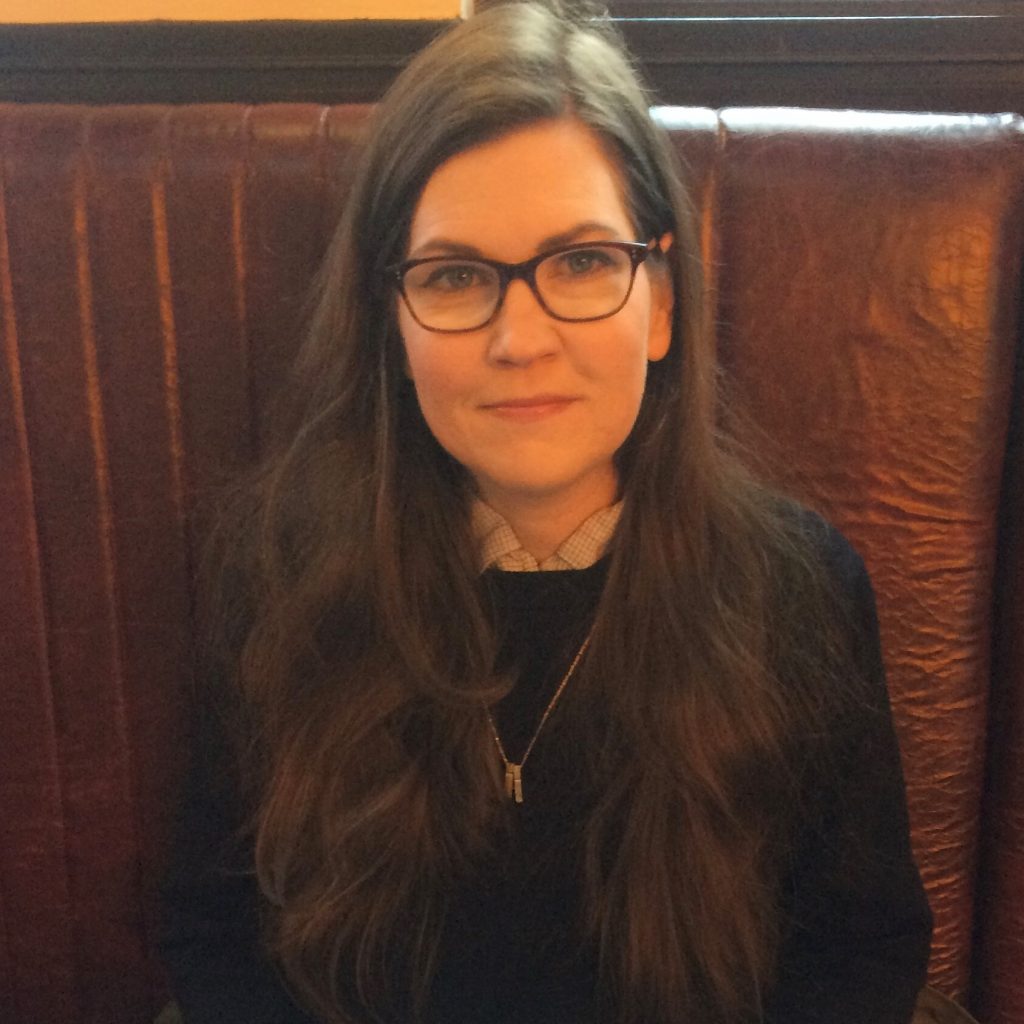 “I am most looking forward to the iPres 2022 Introductions to Posters following Wednesday’s keynote (Wed 14th, 11:00, Foyer 3). Posters are my favourite kind of conference format. It’s a great way to learn about current and emerging work at your own pace, and you get to meet and chat with the people behind it! Also, the iPres 2022 conference organizers have picked an excellent space for poster presentations where it will be easy to browse, ask questions, and engage with other attendees (they won’t be faraway or tucked away in a room somewhere). Given the broad range of digipres topics that will be covered, it’s a good thing the two groupings of posters are divided over two days: the first bunch on Wednesday and the second on Thursday. It will be nice to talk to presenters during the coffee and lunch breaks in the program!”
“I am most looking forward to the iPres 2022 Introductions to Posters following Wednesday’s keynote (Wed 14th, 11:00, Foyer 3). Posters are my favourite kind of conference format. It’s a great way to learn about current and emerging work at your own pace, and you get to meet and chat with the people behind it! Also, the iPres 2022 conference organizers have picked an excellent space for poster presentations where it will be easy to browse, ask questions, and engage with other attendees (they won’t be faraway or tucked away in a room somewhere). Given the broad range of digipres topics that will be covered, it’s a good thing the two groupings of posters are divided over two days: the first bunch on Wednesday and the second on Thursday. It will be nice to talk to presenters during the coffee and lunch breaks in the program!”
6. Ellie O’Leary’s Favourite
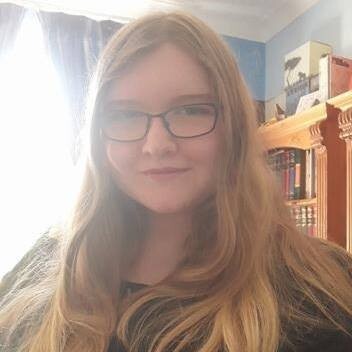 “As a PhD student researching MMO preservation, it is no surprise that the session I am most looking forward to contains a short paper about video game development artifacts. The Online Innovation 1 session takes place online at 4:00pm on Tuesday the 13th and consists of the aforementioned short paper as well as a panel looking at NFTs and preservation. NFTs dominated online conversations last year, especially amongst content creators and digital artists, and so it will be fascinating to hear this discussion from a preservation angle.”
“As a PhD student researching MMO preservation, it is no surprise that the session I am most looking forward to contains a short paper about video game development artifacts. The Online Innovation 1 session takes place online at 4:00pm on Tuesday the 13th and consists of the aforementioned short paper as well as a panel looking at NFTs and preservation. NFTs dominated online conversations last year, especially amongst content creators and digital artists, and so it will be fascinating to hear this discussion from a preservation angle.”
7. Michael Popham’s Favourite
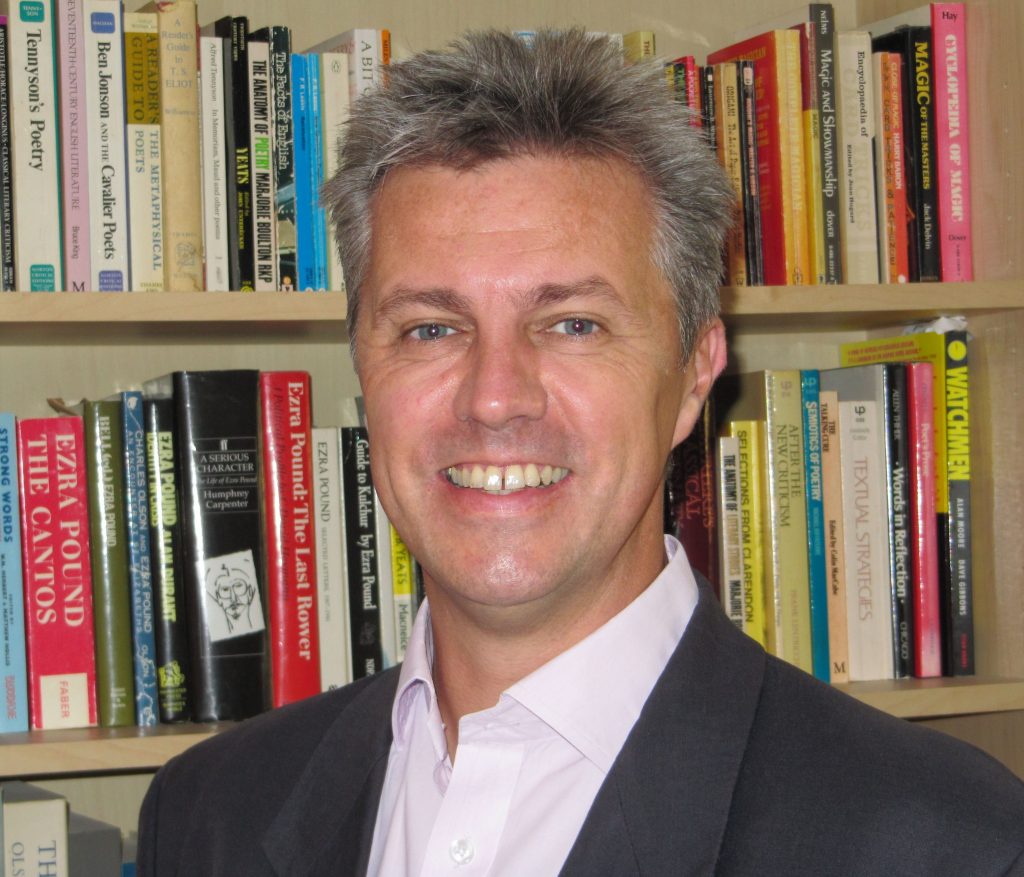 “The session I’m most looking forward to at this year’s iPRES is one that brings together some wise old heads to revisit some long-standing challenges around preserving scholarly digital outputs. Right in the middle of the week, this session in the innovation strand (Innovation 5, Wednesday 14 September at 2pm) will provide vital new insights and perspectives on some major topics that have vexed digital preservations for over two decades. I’ve always been a strong advocate for new forms of scholarly publication, and delighted to see the growth in Open Access books and the sharing of scientific data. But I’ve also been frustrated with how the rush towards novelty and immediate publication seems to come at the expense of any genuine reflection on how we reconcile the needs of innovation with those of long-term preservation. I’m really hoping that this session will help unpick this conundrum.”
“The session I’m most looking forward to at this year’s iPRES is one that brings together some wise old heads to revisit some long-standing challenges around preserving scholarly digital outputs. Right in the middle of the week, this session in the innovation strand (Innovation 5, Wednesday 14 September at 2pm) will provide vital new insights and perspectives on some major topics that have vexed digital preservations for over two decades. I’ve always been a strong advocate for new forms of scholarly publication, and delighted to see the growth in Open Access books and the sharing of scientific data. But I’ve also been frustrated with how the rush towards novelty and immediate publication seems to come at the expense of any genuine reflection on how we reconcile the needs of innovation with those of long-term preservation. I’m really hoping that this session will help unpick this conundrum.”
8. Angela Puggioni’s Favourite
 “Yes, this is definitely biased as I’ve worked with the Dutch Digital Heritage Network for some time, but! I definitely want to attend the Preservation Watch: Working Towards A Supra-Organizational Preservation Watch Function Within The Dutch Digital Heritage Network presentation on Wednesday 14 September at 2pm in the Main Hall. Preservation watch is about monitoring all developments that may influence the life span and sustainable accessibility of a digital information object. Within an organization but also outside. By responding to these developments in a timely manner, digital heritage remains sustainably accessible for everyone in the future.
“Yes, this is definitely biased as I’ve worked with the Dutch Digital Heritage Network for some time, but! I definitely want to attend the Preservation Watch: Working Towards A Supra-Organizational Preservation Watch Function Within The Dutch Digital Heritage Network presentation on Wednesday 14 September at 2pm in the Main Hall. Preservation watch is about monitoring all developments that may influence the life span and sustainable accessibility of a digital information object. Within an organization but also outside. By responding to these developments in a timely manner, digital heritage remains sustainably accessible for everyone in the future.
Just before I made the move to the Digital Preservation Coalition, the DDHN started work on a supra-organizational Preservation Watch function led by a group of experts from the field. I am curious what the group has been up to since then!”
9. John McMillan’s Favourite “Most of my DPC career to date has been spent meeting people on Zoom calls as my starting date occurred just prior to lockdown. For that reason, my choice of favourite session is going to the Conference Dinner and Ceilidh which follows. We’ll meet up at the Grand Central Hotel on Wednesday evening which is very near the iPres 2022 venue, and has a great dancing floor. I am really looking forward to meeting people in person again after all this time and just hope that I can still remember the steps to some of the dances, it has been a while!”
“Most of my DPC career to date has been spent meeting people on Zoom calls as my starting date occurred just prior to lockdown. For that reason, my choice of favourite session is going to the Conference Dinner and Ceilidh which follows. We’ll meet up at the Grand Central Hotel on Wednesday evening which is very near the iPres 2022 venue, and has a great dancing floor. I am really looking forward to meeting people in person again after all this time and just hope that I can still remember the steps to some of the dances, it has been a while!”
10. Robin Wright’s Favourite
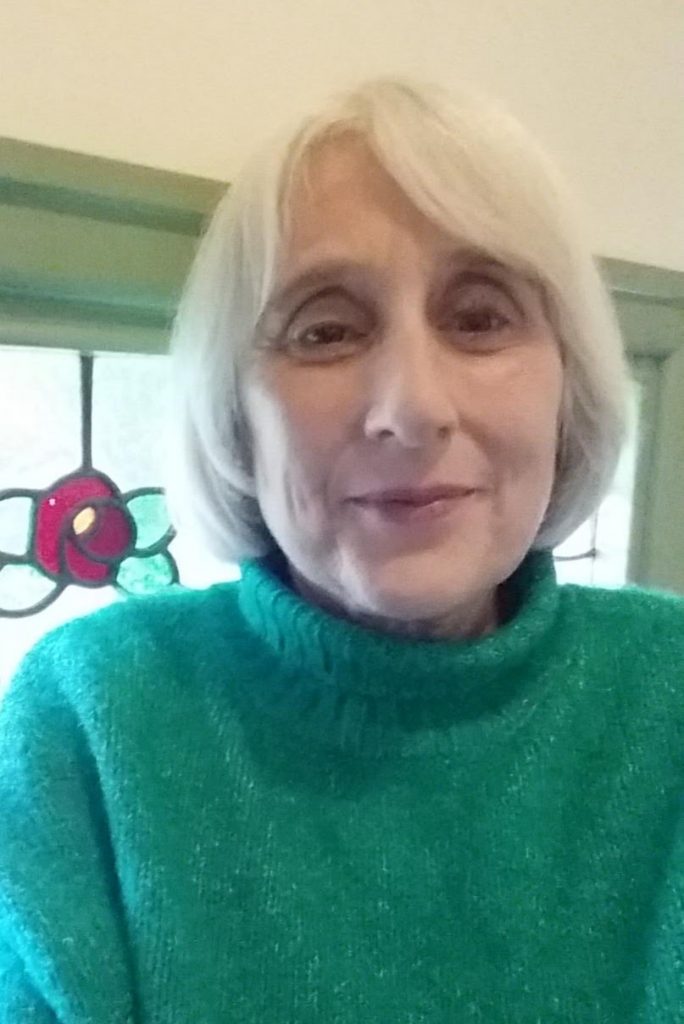 “I’ll be attending iPres virtually from Australia, so I’m really looking forward to the Sunrise sessions that will suit attendees in our time zone as well as the networking opportunities at the iPres radio events that we’ll be holding here each day for iPres fans from our region. I’m also planning to stay on after the Sunrise session on Day 2 to see the opening ceremony and the first Keynote by Amina Shah Video Killed the Radio Star: preserving a nation’s memory (Tue 13th, 9:30, Main Hall). It’s great that it’s being webcast and the time means those of us in the Asia-Pacific time zone will be able to see it live and feel involved with all the other delegates. I’d also quite like to see the workshop by Rachel MacGregor from the University of Warwick on The Climate Crisis and New Paradigms for Digital Access (Tue 13th, 2pm, Rooms 6&7). That’s late at night on our side of the world, but luckily, it’s being recorded, so I will follow that one up later.”
“I’ll be attending iPres virtually from Australia, so I’m really looking forward to the Sunrise sessions that will suit attendees in our time zone as well as the networking opportunities at the iPres radio events that we’ll be holding here each day for iPres fans from our region. I’m also planning to stay on after the Sunrise session on Day 2 to see the opening ceremony and the first Keynote by Amina Shah Video Killed the Radio Star: preserving a nation’s memory (Tue 13th, 9:30, Main Hall). It’s great that it’s being webcast and the time means those of us in the Asia-Pacific time zone will be able to see it live and feel involved with all the other delegates. I’d also quite like to see the workshop by Rachel MacGregor from the University of Warwick on The Climate Crisis and New Paradigms for Digital Access (Tue 13th, 2pm, Rooms 6&7). That’s late at night on our side of the world, but luckily, it’s being recorded, so I will follow that one up later.”
This blog was written for you by the Digital Preservation Coalition team, your hosts at iPres 2022! Give us a tweet @ipres2022 and let us know which session YOU are looking forward to most.
Introducing Glasgow: A Bit of Everything Else
Across the “Introducing Glasgow” blog posts I’ve covered lots of the interesting things to see and do in Glasgow; including food, drink, music, cultural heritage, architecture, and green spaces. This final post is a bit of an “everything else” hodgepodge of other places and things you might want to visit, both in the city and a short hop away.
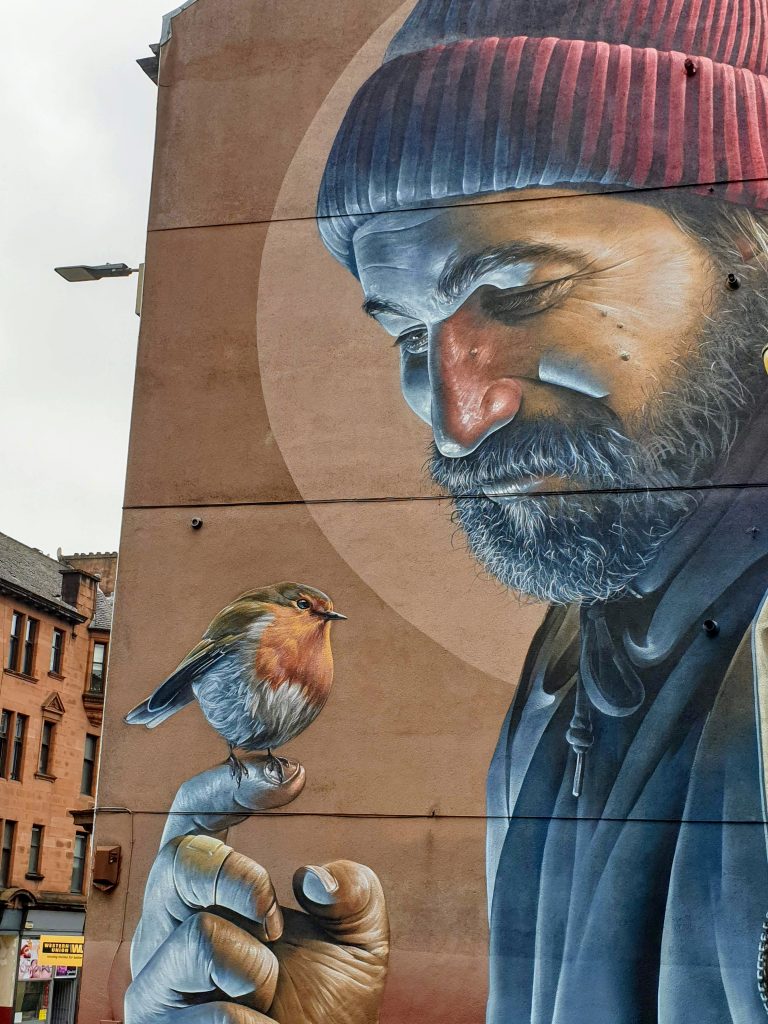
Mural of St Mungo in Glasgow, photo by Sharon McMeekin
First up there is a wide variety of walking tours you might consider joining. I mentioned a personal favourite, the Glasgow Music City Tours in the music themed blog post, and I am also a big fan of the self-guided Mural Trail in the City Centre. Several of the murals are within a 5 minute walk of the conference venue, so worth checking out on a lunch break. If you like something spooky, I’ve also heard good things about the Gothic Glasgow tour. Tripadvisor has a good list of the walking tours available in Glasgow for you to check out.
If you are interested in more cultural experiences Glasgow has a thriving theatre scene, encompassing touring productions, national theatre, ballet, and opera, as well as excellent local productions. For the larger scale productions visitors can look to the Theatre Royal or the King’s Theatre, and for more local or indie fare the Tron or the Citizens. There are also plenty of comedy clubs if you’d like a laugh, including The Stand and The Glee Club.
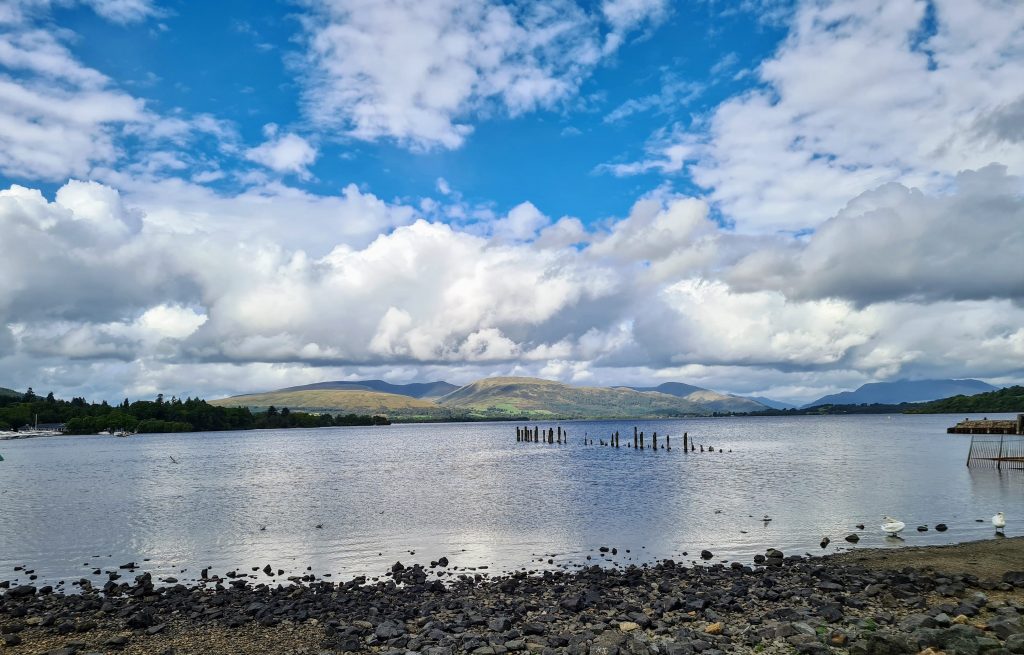
Loch Lomond, photo by Sharon McMeekin
If you’d like to get out of the city for some fresh air, there’s no end of options available, including Scotland’s National Parks and Nature Reserves. The Loch Lomond and Trossachs National Park is just a short train journey from Glasgow and offers a wide variety of options for outdoor pursuits, including boat tours of the stunning surroundings of the 36km (22 mile) long loch. If you’d like a seaside trip, it’s also a short hop on the train to towns like Ayr, Troon, and Helensburgh. The latter also offers the opportunity to visit The Hill House, a stunning example of the architecture and interior design of Charles Rennie Mackintosh and Margaret McDonald. Finally, if you’d like the outdoors AND art, I’d heartily recommend a trip to Jupiter Artland, a sculpture garden covering more than 100 acres that includes works by several big names in contemporary art including Anish Kapoor and Antony Gormley.
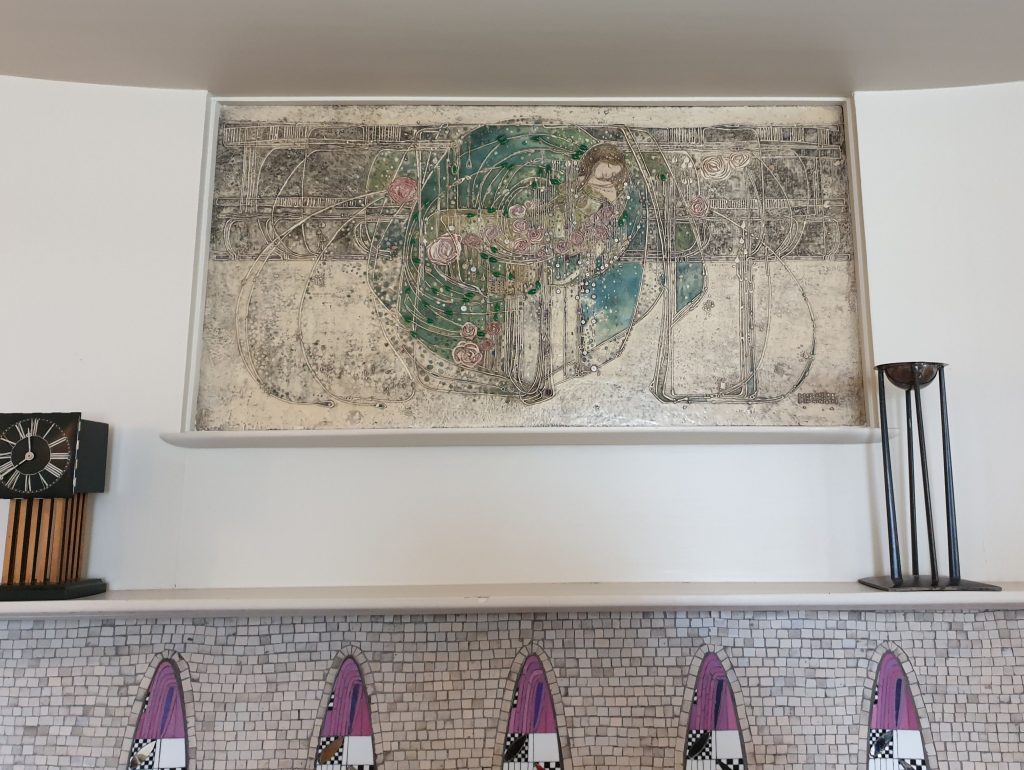
Gesso Panelat Hill House, photo by Sharon McMeekin
There are, of course, also plenty of other towns and cities to consider visiting. Many a relatively short hop on the train from Glasgow. In Stirling you might consider visiting the castle which has been the subject of some fascinating restoration work. In St Andrews you can find the home of golf, ruins of the St Andrews castle, and enjoy an ice cream by the sea. And in Dundee you can visit the V&A Design Museum. Of course, we can’t forget that it’s only a 50 minute train journey from Glasgow to Edinburgh, but we’d need another blog series for all the things to visit there! Do visit the Official Guide to Edinburgh site though, if you are thinking about taking a trip through.
I hope you’ve enjoyed the “Introducing Glasgow” blog series and it has provided you with some ideas of things to do while with us at iPres. For more information on all of the places to visit and things to see make sure to take a look at the Visit Scotland website, and I can’t wait to welcome you all soon!
This blog was written for you by Sharon McMeekin, Head of Workforce Development at the Digital Preservation Coalition and member of the iPres 2022 Local Organizing Committee.
Introducing Glasgow: If Cultural Heritage is Your Jam
So far in this blog series we have covered fun facts about Glasgow, the city’s architectural heritage, its green spaces, the music, and where to eat and drink. Now it’s time for me to let my cultural heritage nerd flag fly freely and give you a quick tour of Glasgow’s eclectic collection of museums and galleries. And the best news is, they almost all have free entry!
Glasgow has one of the most significant civic museum and art collections in Europe, claimed to be the largest in the UK. It is managed on behalf of the city by Glasgow Life, under the banner of “Glasgow Museums”. At over one million objects, valued at more than £1.4 billion, the museum’s collection is the city’s biggest single asset. It includes an extraordinary range of objects and works across art, technology, history, and natural history, which is displayed and stored in ten venues across the city, attracting over three million visits per year. The extent and quality of the collections owe much to the wealth of the city through the industrial revolution and Victorian eras of the 19th century.
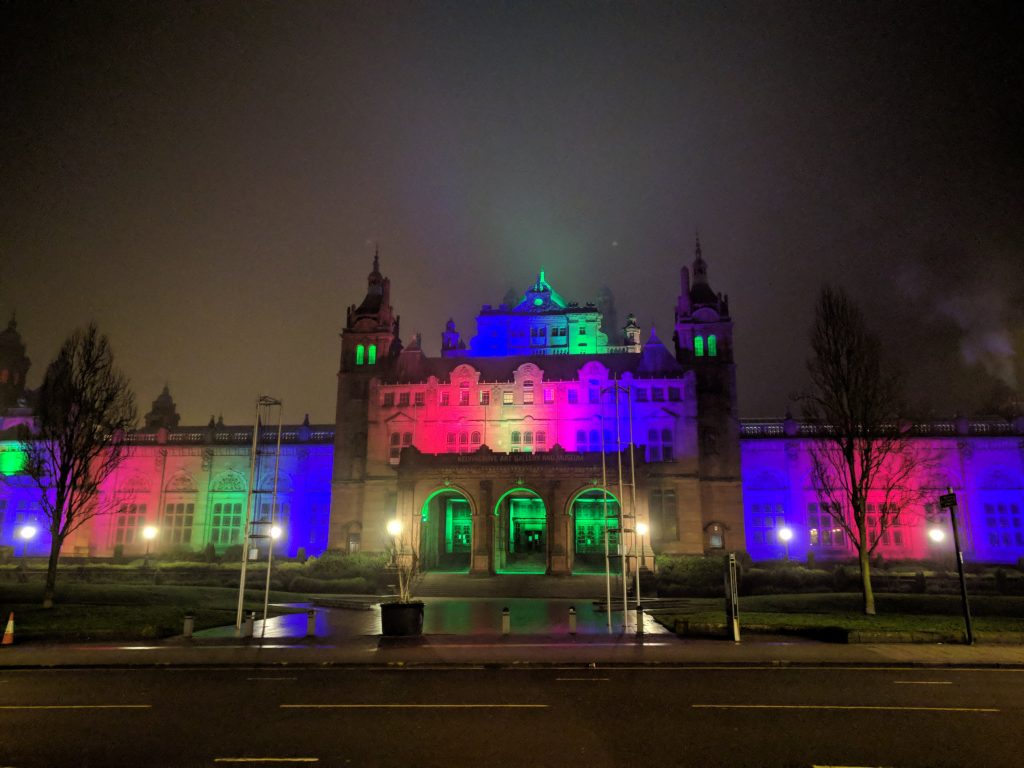
Kelvingrove Museum Lit Up At Night
Glasgow’s flagship museum is the Kevingrove Museum and Gallery in the West End of the city. As mentioned in my previous post on the architecture of Glasgow, Kelvingrove is a grand red stone building designed in the Spanish Baroque style by Sir John W. Simpson, and originally built as the Palace of Fine Arts for the Glasgow International Exhibition of 1901. Amongst its 22 galleries you will find eclectic collections where you can see exhibits including Sir Roger the elephant, Elvis, a spitfire, post-impressionist art, an impressive array of armour and armoury, works by Charles Rennie Mackintosh and his contemporaries, and a taxidermied haggis… One of my personal favourites is the portrait of Glasgow art dealer, Alexander Reid, painted by Van Gogh in 1887. There is also currently a retrospective exhibition of Scottish artist and writer John Patrick Byrne, which closes the Sunday after iPres. How is that for timing!
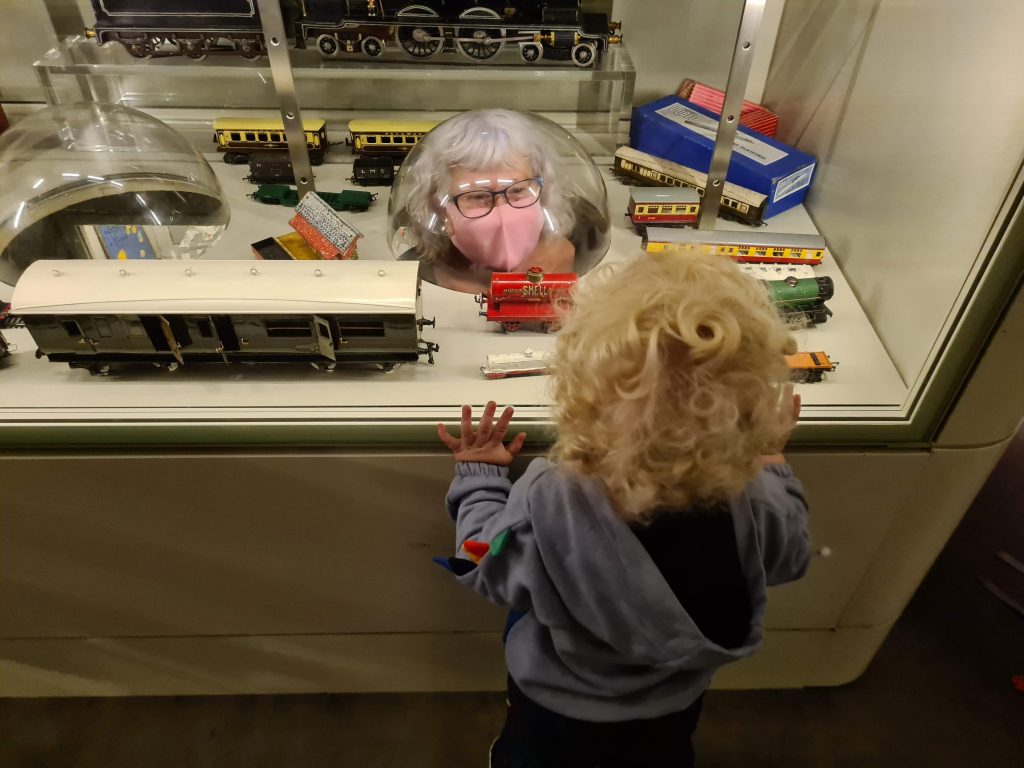
Getting Right Into The Exhibits At The Riverside Museum
Other museums and galleries under the Glasgow Museums umbrella include The Riverside Museum, The People’s Palace, The St Mungo Museum, and The Burrell Collection. The Riverside Museum is home to the city’s transportation and technology collection. It pays tribute to the city’s contributions to heavy industries like shipbuilding, train manufacturing and engineering, and includes the opportunity to go aboard the tall ship Glenlee. The People’s Palace is one of the most idiosyncratic museums I’ve ever visited, and offers a unique view of how Glaswegians have lived, worked and played. It’s a bit dated now, but that actually kinda adds to its charm!
The St Mungo Museum, named after Glasgow’s patron saint and a short walk from the conference venue, has displays focused on religious life and art, exploring the importance of religion in peoples’ lives across the world and across time. And finally, The Burrell Collection houses the extensive collections of shipping merchant Sir William Burrell. Burrell believed in the importance of free education for all, and donated his collection to the city with the stipulation that it should be housed in a countryside setting where the people of the city could appreciate it. The collection includes significant holdings of Chinese art, tapestries, and works by renowned French artists such as Manet, Cezanne, and Degas.
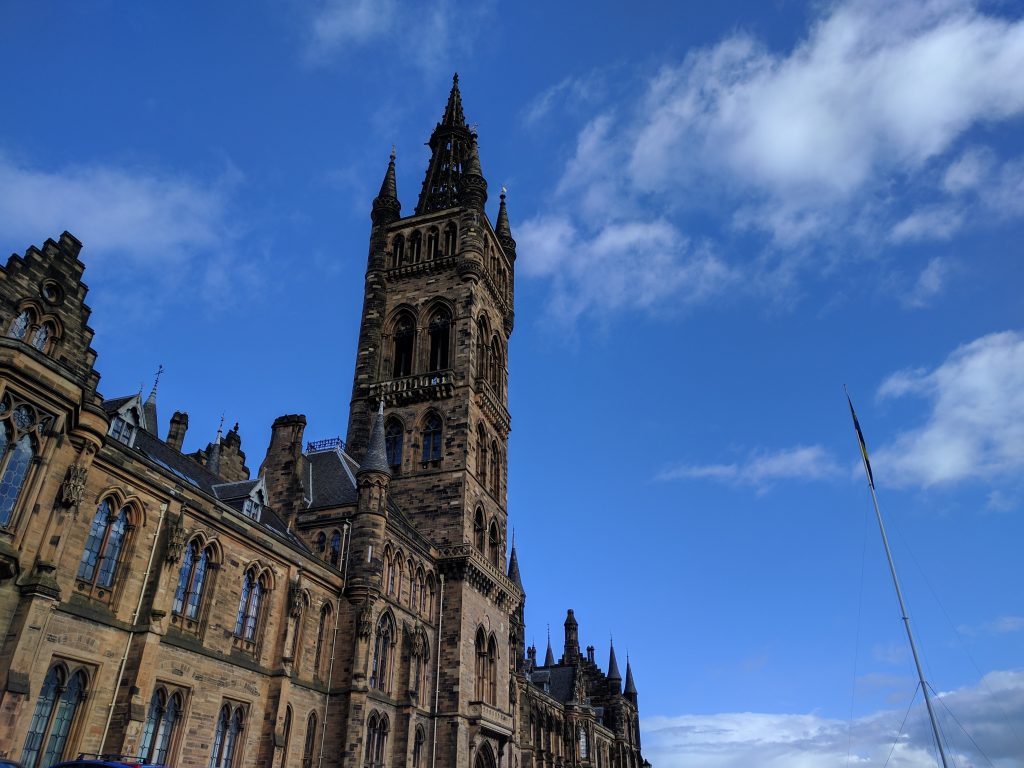
You can find the Hunterian in the university’s main building
Outside of the city’s museum portfolio there is plenty more to see. At the University of Glasgow you’ll find the Hunterian Museum, Hunterian Gallery, and the Mackintosh House. The museum is home to collections relating to Roman Scotland, natural and life sciences (including a large anatomy collection, and scientific instruments used by James Watt, Joseph Lister and Lord Kelvin) and significant collections of coins and medals and objects and belongings brought to Glasgow from around the world during hundreds of years of trade, empire, exploitation and migration. The gallery has permanent displays of works by the Glasgow Boys, the Scottish Colourists, and James McNeill Whistler (the latter includes the contents of his studio bequeathed to the University as a result of the awarding of a well timed honorary doctorate!) The gallery also has the world’s largest collection of works by Margaret MacDonald and Charles Rennie Mackintosh, and attached is the Mackintosh house where rooms from their Glasgow home have been reassembled.
Other museums include Tenement House, a carefully preserved view of Glasgow life in the early 20th Century. There’s the Police Museum, chronicling the UK’s first police force as well as covering policing around the world. At Hampden Stadium you’ll find the Scottish Football Museum, which also offers tours of the national stadium. If you want to know more about Bagpipes, there’s a small Museum of Piping at the National Piping Centre. And finally, there’s the Glasgow Science Centre, although I always think it’s more suited to family visits.
So, no matter what you’re interested in there’s plenty to see in Glasgow if you’re a bit of a nerd like me! If you have time while in our fair city, I’d heartily recommend visiting one or more of our museums or galleries.
This blog was written for you by Sharon McMeekin, Head of Workforce Development at the Digital Preservation Coalition and member of the iPres 2022 Local Organizing Committee.
Why I iPres? Sharing pain and knowledge, learning new stuff, and baked goods (sometimes)!
As I am trying to come up with something “intellectual” and hopefully, useful for the readers as to why I consider the iPres conference series as the most important annual event for anybody remotely interested in digital preservation, I can’t help but remember my very first iPres – iPres 2011 in Singapore. I have three vivid and distinct memories of iPres 2011 – being jet lagged, filling up on the hundreds (I exaggerate of course, but the actual number wasn’t far off) of different food items, frequently served up by our generous host, the National Library, Singapore, and having exposure to some early attempts (e.g. Safety Deposit Box – rebranded as Preservica in 2014) at commercialising the OAIS Reference Model. I also remember being impressed by some of the works presented at the conference, including RODA, the team behind which claimed it to be the “world’s best digital preservation system” – a bold claim that I questioned at the time but was impressed nonetheless.

Photo by courtesy of iPRES 2011
In general, iPres 2011 compelled me to recognise and to an extent, accept two things: the digital preservation issues that I had been grappling with or at least thinking about weren’t unique, and there were of course, digital preservation challenges or aspects that I hadn’t even considered. In fact, these observations have become consistent attributes of the iPres conference series over the years. For example, PREMIS has proliferated through the wider digital preservation and archiving communities as the “go-to” international metadata standard for its practical implementation model but some of the research conversations involving PREMIS seldom happen outside an iPres event. During my attendance at iPres 2019 in Amsterdam, I remember discussing with a fellow attendee about the practicalities and benefits of capturing PREMIS events even before an object enters the preservation system. This concept of capturing pre-ingest events was something that I hadn’t given much thought to before but that conversation motivated me enough to implement something basic (a combination of Python scripts and MongoDB) but useful for my current work at Qatar National Library.

Arif during a Q&A session at iPRES 2011
Another such example takes me back to iPres 2011 again where I had an intriguing conversation with a Masters student from a university in Portugal, who was not only filling in for someone else but was also introduced to the world of digital preservation at that same event. The reason I remember this conversation as an intriguing one is because of the innovative ideas that the student had about combining machine learning with digital preservation models to develop an intelligent preservation watch (monitoring technological obsolescence) and planning service. I have yet to see a practical implementation of such a novel approach to preservation watch.

The iPRES 2011 give-away
Of course, fostering knowledge sharing (which could often work as a support system for the pained practitioners) about common problems while offering a platform for showcasing new findings and thoughts should be expected from a premier conference series like iPres. Fortunately, every iteration of iPres managed to maintain a level of quality for both the content presented and the social factors to ensure those core attributes.
In terms of the social factors, a few recent iPres events attempted to combine informative sessions with a unique dose of entertainment. iPres 2019 had a bake-off session that provided attendees with real baked goods (of reasonable quality) while they participated in sessions about highly technical aspects of digital preservation, such as file format identification and Oxford Common File Layout (OCFL). I can’t think of any other digital preservation conference that has attempted something like that in recent years!
Personally, I feel that no iPres event came close to matching the astounding hospitality that I enjoyed during the iPres 2011 conference in Singapore. But I am hoping that iPres2022 hosted by our friends at the Digital Preservation Coalition (DPC) in Glasgow will finally top that (no pressure!).
Arif Shaon
Senior Digital Curation Specialist
Qatar National Library
Introducing Glasgow: Fancy a Drink?
Last month on the iPres 2022 Blog I gave a whistle stop tour of what Glasgow has to offer for foodies. So this month it seemed only fair to follow that up with a few suggestions on where you might enjoy a beverage or two during the conference. What kind of Scot would I be if I didn’t do that? (Probably thrown out of the country for lack of hospitality, we Scots take that seriously!)
Now, while I enjoy a wee drink, I fully appreciate that not everyone wants to consume alcohol, and nor should they ever feel peer pressure to. So I’m going to start off with a few suggestions of where you can get a good cup of coffee, tea, or other soft beverage near the iPres conference venue. Many also offer tasty food and cakes if you want to have a break from the conference treadmill.
First up, if coffee is your vice then there are some great, non-chain, options within a short walk of the conference venue. Tinderbox has become something of a Glasgow institution since opening their first store in Glasgow’s West End more than 20 years ago. Offering a range of coffees, teas, juices, cakes, and more, their Merchant City espresso bar is just round the corner from the Technology and Innovation Centre (TIC). Singl-end is also incredibly popular, with rave reviews for their various brunch options, coffee, and cakes. They also have a wide range of gluten-free options. Just a couple more minutes walk away and you’ll also find Wilson Street Pantry (I love their eggs benedict) and Spitfire Espresso. If you’re interested in having an afternoon tea while in the UK, then the Cup tearooms are the place for you. It also handily turns into a gin bar at night, but more on that later. Finally, the all vegan Picnic can meet your caffeine needs but also offers a range of healthier juice or smoothie options if you are needing more colour in your diet (we all get to that stage with conference catering, right?)
 Lots of Glasgow pubs are dog-friendly
Lots of Glasgow pubs are dog-friendly
Onto the places to grab a drink or two after a long day of concentration. Now, I must admit that most of my usual haunts are in the West End of Glasgow, but I can hopefully still make a few good recommendations! Since this is Scotland, let’s start with a couple of good places to grab a glass of whisky. Ask a local what the whisky bar in Glasgow is and 9 times out of 10 they will tell you it’s The Pot Still, a 10-15 minute walk from the TIC. They have hundreds of whiskies to choose from, but also helpful staff happy to make a recommendation. For non-whisky drinkers they also have a wide range of bottle beers and real ales from proper hand pumps, as well as a great selection of other spirits. If you want something slightly closer to the TIC, you can find The Piper Whisky on the corner of George Square about five minutes walk away. They claim to stock a whisky from every distillery in Scotland and a full list, including tasting notes, is available on their website.
For those who prefer other spirits, and perhaps a cocktail or two, there are some great options nearby too. As mentioned above, the Cup tearooms morph into gin bars in the evening called Gin71 (two locations within walking distance of the TIC). As the name implies, they offer 71 different gins to choose from, along with a wide range of mixers, garnishes, and cocktail options. I can say from experience that they mix a mean martini, and I’d also recommend one of their gin flights if you’d like to taste a few different things. They do offer a range of wines, other spirits, beers, and soft drinks too. For those in search of a cocktail, you might also consider visiting The Spiritualist, The Anchor Line, or The Atlantic (the latter two are next door to each other), all about 10 minutes walk from the TIC, or you could venture just a little further to Tabac on Mitchell Lane which also has a great wine list.
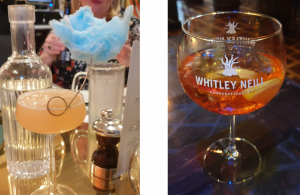 Have a Candy Floss Martini Or an Aperol Spritz… Sláinte!
Have a Candy Floss Martini Or an Aperol Spritz… Sláinte!
Now for my personal favourite, beer! Sadly my favourite Glasgow brewery, Overtone, hasn’t managed to open a tap room yet, but you can often find one or more of their beers on tap at Schilling Brewing Company, a 10-15 minute walk from the conference venue. Arguably the best place to go in the centre of Glasgow for craft beer fans, they usually have at least 20 different craft beers on tap. Many will likely be familiar with the Brewdog craft beer group, and their flagship Glasgow location is less than 10 minutes walk from the TIC, offering a range of their own beers alongside a rotating menu of guest brews. If you like stunning architecture, green spaces, and beers brewed according to the Reinheitsgebot, the German Purity Law of 1516, then West on the Green is the place for you (it’s about a 15 minute walk from the TIC). In fact, fans of European beers are well served in Glasgow. For more German-style beers there is the Bavarian Brauhaus, for those who like Italian beers there is Doppio Malto, and for beer from a broad mix of locations there is the Beer Cafe.
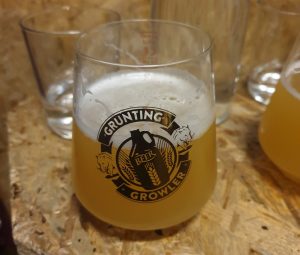 Enjoy a craft beer while in Glasgow
Enjoy a craft beer while in Glasgow
Unfortunately, my own favourite destination for beer drinking, Grunting Growler, is only open Thursday to Sunday and is out in the West of the city, but if you love beer and are staying an extra night or two then I recommend checking it out. Real ale fans will also notice I’ve not mentioned any bars for you, this is because all of the best real ale bars are in the West or South of the city, but if you want to venture a bit further I can supply some recommendations.
Other bars you might consider visiting nearby for more general fare include Bar 91, St Luke’s and the Winged Ox, The Amsterdam, Pavement, and Babbity Bowsters. I’ve also just heard that one of my favourite bars, Blackfriars, which succumbed to the Covid-related hospitality crisis, is reopening in July, so in time for iPres! The team behind the reopening currently run an incredibly popular bar on the other side of the city centre, The Duke’s Umbrella, so I’m excited to see them bring back Blackfriars.
So, that’s another quick dash through Glasgow! The eagle-eyed of you will notice that I didn’t specifically cover wine bars but, like with real ales, the best of those are in the West or South of the city. Also, I’m still in the process of finishing the full list of eating and drinking recommendations which will be published on the iPres website, but it’s nearly done, promise! And all of the locations will be added to a special Google map. I look forward to raising a glass with you all soon, sláinte!
This blog was written for you by Sharon McMeekin, Head of Workforce Development at the Digital Preservation Coalition and member of the iPres 2022 Local Organizing Committee.
Why I iPres: Another Journey by Kieran O’Leary
This year marks my first appearance on the iPRES Program Committee, and it will be my first time going to iPRES in-person. When I think about the question: “Why I iPRES?”, the simplest answer is that it’s quite essential that I attend this conference based on my current Digital Preservation Manager role in the National Library of Ireland. I’ve peer-reviewed some papers, seen the titles and authors of others, so I know that it’s going to be a pretty wonderful and important conference. I would like to use this blog to reflect on my experience of iPRES, and I hope that might be especially useful to first time attendees, those on the fence about attending, or even contributors to the Ad Hoc program. The Ad Hoc program has just been announced, and I think that the lightning talks and posters are an ideal way for everyone to share their work, but it’s a particularly good first step for first time contributors.
As with many things in my career, my very first experience of iPRES is linked to Dave Rice, Ashley Blewer and Jérôme Martinez. I proof-read and gave some very basic feedback on their 2016 paper on the standardisation of FFV1 and Matroska (Audiovisual formats with a focus on long term preservation). I was only working in archives for about 3 years at that stage, and I was still not fully working on digital material then, as half of my time was still working on 16mm and 35mm film. I remember reading the 2016 program, and all subsequent programs and I desperately wanted to attend. This was never possible as the travel and ticket costs were just too prohibitive at the time. I found it really interesting to read Ali-Hayes Brady’s blog as there’s a lot of crossover with our experiences – first discovered iPRES in 2016, and this will be our first time attending!
I got my first chance to attend iPRES, albeit virtually, when the National Library of Ireland purchased my ticket for the 2021 conference. My goal here was to just soak in as much information as possible, get inspired by seeing the work of others, see how I could contribute as a member of the program committee for the 2022 conference, and how I might be able to get a paper accepted in future. I found myself using the chat function on Zoom so much, asking questions or just talking to other members of the community. I loved the congenial and even casual atmosphere, it reminded me quite a bit of No Time to Wait actually, which is the best compliment that I could give any conference. I think I’ll actually miss the chat function when moving back onto the in-person attendance, and I’m strongly considering logging into the online platform simultaneously while in Glasgow, just to get access to the communication!
I’m hoping that the cheaper virtual tickets and the hybrid conference structure will persist after this year, as I want iPRES to be available to the greatest number of people. It is possible to learn so much, to meet so many people, and having a more affordable option that doesn’t involve flights and accommodation will increase accessibility across the globe. We don’t want people and institutions to be priced out of attendance.
The Ad Hoc program for iPRES 2022 has just launched. In most conferences, the highlight of my experience is often the lightning talks. The beauty of a lightning talk is that it really encourages newer professionals, or first-time contributors, so there’s the greatest opportunity to see emerging people in our field. It also provides a safe space to show unfinished work, or perhaps share an idea or an issue. I liken it to attending short film programs at a film festival, it’s often the best bang for your buck!
I’m a little anxious about getting back to a crowded, in-person conference, but I am mostly just super excited to see old friends, and meet new people, and to see new approaches to how we do our work. I often find that really good conferences recharge my batteries, inspire me to do better work, learn more and explore new ideas and approaches. I know that I’ll get the most out of this conference if we get some new people and institutions contributing to the conference, so please do think about submitting a digital preservation game or a lightning talk, we all want to see your wonderful work!

Kieran O’Leary
Digital Preservation Manager
National Library of Ireland
Introducing Glasgow: Where the Food is More Than Fried Mars Bars!
Scottish cuisine has a notorious reputation internationally. I imagine if I asked you to think of Scottish food your first thought would either be haggis or deep fried Mars Bars, neither of which you likely find appealing. Well, hopefully in this blog post I’ll manage to do three things:
- Persuade you to give haggis a chance!
- Explain why deep fried Mars Bars are not really a common part of Scottish cuisine. And..
- Help you see that there is much to enjoy amongst the Glasgow food scene while you visit for iPres 2022.
Let’s start with haggis, for the weak of stomach I won’t list all of the ingredients, if you’re keen you can find details on Wikipedia, but let’s just say it’s made from what might be characterised as the “leftover bits” of a sheep, along with onions, oats, and spices. Confession time: for the first 22 years of my life I wouldn’t touch the stuff because I thought it sounded gross, a betrayal of my Scottish ancestry second only to my hatred of whisky…. But in 2001 at a university potluck dinner, where we had to bring food from our home country, a friend brought along vegetarian haggis and persuaded me to try it. Turns out veggie haggis (which is usually also vegan) is a gateway haggis. Soon I was scarfing down the real stuff regularly. It’s SOOOOO GOOD. All those years I’d missed out on the joy of haggis that I would never get back…
 Photo courtesy of the Glasgow Convention Bureau: Address to the haggis
Photo courtesy of the Glasgow Convention Bureau: Address to the haggis
The old school cooking encyclopaedia Larousse Gastronomique describes haggis as having an “excellent nutty texture and delicious savoury flavour”, and if you add in a mention of spicy, peppery-goodness, I think that’s the description nailed. The traditional way to serve haggis for occasions such as a Burn’s Supper is with mashed neeps (swede/rutabaga) and tatties (potatoes), but it’s a remarkably versatile food and comes prepared in many different ways. One of my personal favourites is Chicken Balmoral, which is a chicken breast stuffed with haggis, wrapped in bacon (or prosciutto if you’re feeling posh) and served with a whisky cream or pepper sauce. Delicious. I’ve also had it in many other weird and wonderful forms including:
- Haggis bon bons (balls of haggis covered in breadcrumbs and either baked or fried)
- Haggis pizza
- Haggis spring rolls with Chinese-style curry sauce
- A haggis supper (battered haggis with chips)
- Haggis pakora
And I’ve recently spotted haggis lasagne on a restaurant menu in Glasgow. I think I might visit there soon! Here endeth the haggis sales pitch, but, really, give it a go. I tried sea anemone when I was in Japan, so you can try haggis in Scotland!
Next on our list, the deep fried Mars Bar. Now, I’ll give you that Scotland’s reputation as purveyors of fried food is to a certain extent warranted. Indeed, there is some debate about whether fried chicken originated in Scotland or China. And, when, on the odd occasion, I feel like eating something that has a high chance of immediately solidifying my arteries, I’ll enjoy the local delicacy of pizza crunch (a portion of cheap pizza battered and fried from the local fish and chip shop….). But I won’t accept the notion that we’re regularly chowing down on fried Mars Bars.
There is debate about who first had the “bright” idea to batter and fry a Mars Bar, but all of those claiming responsibility are in the North East of Scotland in Aberdeen and the surrounding areas, i.e. not Glasgow! All claims also tend to come with a qualifier that it was done as a joke. And while a chip shop in the Weege would usually make you one if you ask for it, it is not a regular menu item here as it is in Edinburgh, where they have become a tourist favourite. I’ve only ever had a single bite of one, and that was enough to last me a lifetime. So, deep fried Mars Bars: created as a joke and not regularly consumed by anyone but tourists….
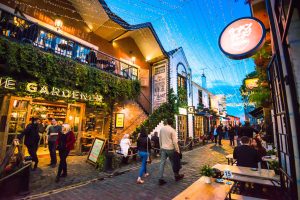
Photo courtesy of the Glasgow Convention Bureau: Dining in Glasgow
Finally, let’s talk a little about the food scene in Glasgow. When I first came to live in Glasgow for university in 1997, I will admit the quality of offerings around the city were nothing to get excited about. I am, however, happy to report that things have drastically improved in the last 25 years and there are now plenty of gastronomic delights to be had. A simple example of this is that for many years there were no Michelin starred restaurants in Glasgow, but now we have two: Cail Bruich and UNALOME by Graeme Cheevers. There are also four that hold the Bib Gourmand rating (“exceptionally good food at moderate prices”) and 16 restaurants in total in the guide. Amongst the Bib Gourmand rated restaurants I’d particularly recommend Ox and Finch, which offers a constantly evolving menu of small plates that showcase local produce.
The city has also benefited from the many different amazing communities of new Scots who have immigrated to Glasgow over the years. You’ll find a broad range of cuisines represented amongst Glasgow’s restaurants. One thing not to miss while in Glasgow is heading to an Indian restaurant for a curry. Mother India and the more informal Mother India’s Cafe are beloved Glasgow institutions in the West End, and there are plenty of options closer to the conference venue including Swadish, Madha, Green Gates, and more.

The Luther Burger at Bread Meats Bread
The city has also seen its fair share of food fads, periods where lots of similar restaurants would appear at once. It started with burgers (Bread Meats Bread is my favourite of those), then street food, and the most long lasting trend has been around pizza. From the “non-conformist” Pizza Punks, through the trendy Nonna Said, to my absolute favourite Paesano. Just a short walk from the iPres conference venue, Paesano regularly makes lists of the best pizza restaurants in the world. Serving super fresh Neapolitan-style pizza at great prices (a pizza and non-alcoholic beverage will cost you less than £10), it would be my number one recommendation if you have a free night and need to grab a quick bite. The only issue is they don’t take bookings so there is sometimes a bit of a wait for a table.

Pizza at Paesano
One other important thing to mention is that, despite the fact Scots are known as unhealthy, deep-frying, meat-eaters, Glasgow is actually a very vegan friendly city. I will admit now that this is not my area of expertise, but I can point you towards the Glasgow Vegan Guide to find out more about the best vegan and vegan-friendly restaurants in the city.
So, this was a very quick whistle stop tour through Scottish food and the restaurants of Glasgow, but there will be more information available for those of you attending iPres 2022 in person. I’ve already started compiling a list of recommended restaurants, cafes, and places to enjoy the odd beverage or two…. We’ll be getting it up online here on the iPres website as soon as it’s done. And don’t forget, give haggis a chance!
This blog was written for you by Sharon McMeekin, Head of Workforce Development at the Digital Preservation Coalition and member of the iPres 2022 Local Organizing Committee
Why I iPres: How to Obsess About Checksums (Correctly)
I have attended quite a few iPres conferences, and also served on the programme committees for a few. I remember the early ones in Vienna (2010) and China (2007) and the more recent ones in Kyoto (2017) and Amsterdam (2019). I think iPres is the best place to talk about checksums, or any other key topics related to digital preservation.
If you work in digital preservation, it is unlikely that you would not have heard about checksums – I believe this to be an accurate statement, as they feature prominently in digital preservation.
Checksums can be used to determine fixity of digital objects, the property of an object being unchanged. Libraries and archives commonly operate checksum-based fixity checking workflows to detect change of an object, as routine inspections of data at rest, or to determine the sameness between two copies of an object before and after a certain event, e.g. one that involves moving the object from one location to another.
I have had various roles since I have left the British Library and the Internet Archive and joined the University of Notre Dame in 2016. I have worked exclusively in the University’s central IT department in the last three years, leading strategy development and implementation of enterprise storage and digital asset management services. Checksums are occasionally used, e.g. to verify software packages before distributing to many endpoints, or where required to verify the correctness of data migration efforts. It is not that data integrity isn’t important to IT, it is just that object integrity validation is directly impacted by the size of the file or the volume of data. Routine checksum calculation and verification at TB/PB scale is resource-extensive, and hence impractical, requiring compute power as well as the underlying storage to have low latency and high performance I/O. For data migration, we often use simple methods such as comparing expected file size and file count to provide basic fixity information. We also rely on built-in fault-tolerance features of storage systems or data management systems for data storage and transfer integrity.
Checksums remain a valid way of verifying data integrity. Just as our thoughts have evolved on format migration, another prominently featured digital preservation task, I sometimes wonder if there is a degree of over-focus on checksums within the digital preservation community. It is certainly necessary to take a closer look. We hear a lot about checksums but very little about its limitations such as scalability or associated costs. We do not hear about checksum mismatches or follow-up actions – or would repeated (good) matches lead to less need for fixity checks? There should be more information available about some (important) details, such as the various use cases, the frequency and the factors impacting the choice of frequency. I have witnessed lengthy discussions about the choice of specific hashing algorithms, but if our purpose is to ascertain sameness or detect changes, we may not necessarily need the most cryptographically secure checksum. It is perhaps more important to consider performance, or alignment with the storage systems, to take advantage of the built-in fixity feature and make sure what you PUT there is exactly what you GET back. An example of this is S3’s new checksum support, that persistently stores and allows you to retrieve checksums, making it easier to build fixity workflows incorporating pre-calculated and/or S3 generated checksums.
Digital preservation is about managing risks, and we have established that bit flip is not a top reason for data loss. After having explored and built some understanding of how to use fixity to help us manage the risk of data loss (which will always exist), perhaps  it is time to turn our attention and resources to understand and address some other (bigger) challenges? I would also cautiously advise that as long as we understand the durability claims by storage vendors and put in place the necessary mitigations (e.g. multi-region, multi-cloud, risk acceptance), we probably do not need routine fixity checks while data is at rest under the care of a vendor.
it is time to turn our attention and resources to understand and address some other (bigger) challenges? I would also cautiously advise that as long as we understand the durability claims by storage vendors and put in place the necessary mitigations (e.g. multi-region, multi-cloud, risk acceptance), we probably do not need routine fixity checks while data is at rest under the care of a vendor.
If we want to obsess about something new that is crucial to the longevity of our digital heritage, may I point to another category of technical dependency: storage intermediaries. These are software, and sometimes hardware appliances that act as a link between applications and storage media, performing a range of tasks, such as protocol translation, caching, compression or even encryption. While they perform useful functions and reduce the size of data transferred and stored, they also introduce deep dependencies and must be present for rendering and interacting with bits sequences stored on physical media. This topic warrants a separate blog post but I would like to reference our iPres 2020 paper that discusses it in some depth. I hope we become aware of the impact and find ways to address it collectively.
Helen Hockx-Yu
Enterprise Architect
Office of Information Technologies, University of Notre Dame
Why I iPres: an iPres journey by Ali Hayes-Brady
I will preface this blog with a statement: the 2022 iPres Conference will be the first one I have been able to attend. Now I know what you’re thinking – how can I talk about “Why iPres” if I’ve never officially… iPres-ed. Well, read on and I shall tell you all about my iPres journey and how excited I am to be attending this year.
I first became aware of iPres in 2016. I, a newly qualified information professional, was working for the BBC in the UK. I was interested in digital records and trying to get to grips with the wide, weird, and wonderful world of digital preservation. Through my Twitter fumbling I found a hashtag that caught my eye… #ipres2016. I followed along, lurking behind my personal Twitter account, devouring any and all content I could find that was coming out of Bern. After the conference I would periodically check the hashtag and read the blogs and view the posters and (some) presentations that were posted afterwards. Seeing the stickers that folks had collected was the last straw – I knew then and there that I wanted to do this. I wanted to be involved in digital preservation and *someday* go to iPres for myself.
iPres 2017 came and I was still living in Reading, UK – a far cry from Kyoto. Again I spent the week checking up on the hashtag and living vicariously through the people live-tweeting their experiences. I don’t think I was brave enough yet to interact but I was bookmarking and reading and following and again I felt like this was an event for me – the camaraderie, the jokes, the collaborative nature of the whole thing, it all just seemed like such a good time.
2018 came and I had only recently moved to Australia and so I knew I’d be iPres-ing the way I had the years before – from behind a screen, this time in my PJs because time differences are great and Boston is far away. I had begun, at this stage, to recognise some familiar names and looked forward to following the collaborative notes and trying to remember the specific papers and posters I wanted to find out more about.
When iPres 2019 rolled around, I was finally working in the field, having been appointed Monash University’s Digital Archivist earlier that year. I was new to the role and bubbling with excitement and, unfortunately, still in Melbourne and nowhere near Amsterdam. But this year I was interacting with, commenting on, and liking posts from the folks I’d been quietly following for years. I was able to find even more people to follow and then, after the event, Australasia Preserves (a digipres community of practice for our neck of the woods) held a conference reflections session and some of our members who had been talked about their experiences. I felt like I was getting closer and closer. Surely 2020 would be the year I finally made it.
…
Well, we all know how that panned out. BUT the WeMissiPres festival happened in 2020 and it was wonderful. I spent three days in my home office laughing and chatting to my colleagues all over the world, hearing about some fascinating projects and dreaming of going to Beijing in 2021.
2021 had other plans however and I was unable to attend Beijing as I had a small baby to look after who, while delightful, was not super keen on letting me spend a few days online.
But now, finally, I am going to iPres. It has taken me 6 years to get here and I am thrilled to be attending. And while I am still going to be sitting at my computer in my home office in Melbourne – this year the hybrid nature means there is a dedicated online program with events and discussions and all the fun of the conference at my fingertips.
So, why iPres? For me the answer is very simple – I’ve wanted to go for so long and am finally getting the opportunity. I want to say to anyone who is like me, anyone who has skirted around the edges and maybe feels like they could maybe go in a year or two – don’t wait. Whether you’re new to the field or live so far that attending conferences like this has never been an option, now is our chance – Early Bird registration is open and I really hope I’ll “see” you there too.
Ali Hayes-Brady
Digital Archivist
University Archives, Monash University
Introducing Glasgow: A City of Music
As iPres 2021 drew near, at the DPC we began to throw around ideas of what gift we could offer delegates to accompany the official announcement at the end of the conference of iPres 2022 in Glasgow. Due to Covid restrictions and the hybrid nature of the conference it wouldn’t be possible to offer a physical gift as many previous hosts have offered (who wouldn’t love the iPres 2019’s tulip bulbs!) We wanted it to be something fun, that the digital preservation community could enjoy, but how to achieve that with something intangible?
In the end the idea we landed on was inspired by Glasgow itself: a Spotify playlist of songs about and/or by artists from the city. Glasgow has an eclectic and vibrant music scene that has long been a key part of the city’s history. I read in an article when fact checking this blog that “music runs through the blood of Glasgow, through its streets and architecture, where tenement flats vibrate with the music conceived in and around them.” It is truly an essential part of the soul of the city. I imagine most of us will have been to a gig where the band has waxed lyrical about how they are currently playing to the best crowd in the world, but many have confirmed that Glasgow is the city where that is most often the truth!
In fact, music plays such an important role here that the city was named a UNESCO City of Music in 2008, the first city in the UK to gain the honour. And with nearly 200 music venues and an average of 330 ticketed gigs a week, it is easy to see (or hear?) how this status was achieved. You can also add in that the OVO Hydro, used primarily for concerts, was the 2nd busiest venue in the world in 2019, after only Madison Square Gardens in New York. Glasgow is also home to Scottish Opera and the Royal Scottish National Orchestra alongside other national organisations including the BBC Scottish Symphony Orchestra, the National Youth Orchestra of Scotland, the Royal Conservatoire of Scotland (one of the top 5 performing arts schools in the world) and the Scottish Ensemble. The city has also produced plenty of artists you’ll have heard of, including Simple Minds, Primal Scream, Franz Ferdinand, Texas, Belle and Sebastian, Deacon Blue, Chvrches, Frightened Rabbit and more….
 The Oran Mor venue
The Oran Mor venue
Now, I know we all keep pretty busy during iPres week, but if you find yourself with some spare time in the city, it won’t be hard to locate some live music. The events listing on Data Thistle is a good place to see what’s on. This could be anything from the Traditional Scottish music sessions at venues like the Machair and Ben Nevis, through smaller venues like the Glad Cafe, the Hug and Pint, Stereo, Oran Mor, SWG3, the Old Fruitmarket, and St Luke’s, through to bigger hitters like the Hydro, the Clyde Auditorium, The Royal Concert Hall, and the O2 Academy.
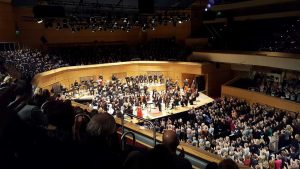
The Royal Concert Hall
 The O2 Academy
The O2 Academy
And there can be no forgetting two of Glasgow’s most iconic venues: King Tut’s Wah Wah Hut and the Barrowland Ballroom. For such a small venue, King Tut’s is packed with atmosphere, and also seems to attract the most urban mythology! If all the people who claim they “were there” on the night Oasis were signed at King Tut’s in 1993, the venue would have had to be magically 10 times larger than night…
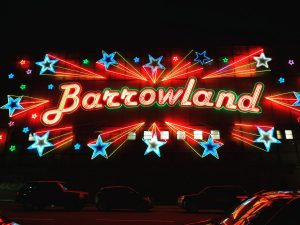 The Barrowland Ballroom
The Barrowland Ballroom
Finally, for me there is no more quintessential Glasgow music experience than a concert at the Barrowland Ballroom. Sporting a giant neon sign outside (claimed to be the biggest in the UK), a sprung dance floor that gives the crowd extra bounce, and some of the best acoustics you could ask for, the affectionately known “Barras” has long been part of the Glasgow music scene. Acts from David Bowie to The Clash to U2 to The Foo Fighters have graced the stage. I’ve been there more times than I can count, and still clearly remember my first trip to the Barras to see Portishead in 1997.
If you’re interested in hearing about the history of the music scene in Glasgow and you have the time while you’re here, I can personally recommend the Glasgow Music City walking tours. They are run by a group of local music journalists whose knowledge is encyclopaedic and who have plenty of entertaining stories to tell!
This blog was written for you by Sharon McMeekin, Head of Workforce Development at the Digital Preservation Coalition and member of the iPres 2022 Local Organizing Committee
Why I iPres: You can’t collaborate alone!
My first iPres experience was in 2013 when I came for the last day of the conference in beautiful Lisbon, to attend a workshop as part of the 4C Project (for which I was the DPC’s Project Officer at the time). Arriving late meant I’d missed all the fun it seemed, there were lots of stories about great papers, the conference dinner and unforgettable moments – but I was fairly new to the community, my background was in a completely unrelated field, so I was quite happy to sneak in and out again without the conference leaving much of an impression on me, or of me on it.
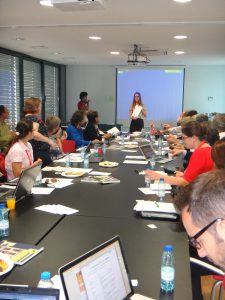
A brief stop in Lisbon to attend the 4C Project Workshop
The next iPres I attended was in 2019 in Amsterdam however, and this was different!
I spent the full week at the EYE Film Museum with digital preservationists from all over the world and came away elated with the feeling that I’d contributed materially to the conference. I knew people already by then certainly, but at the conference I met MORE people, made new connections, had a plethora of through-provoking conversations and experiences, people were interested in what I had to say, I felt energised and enthused! I felt part of the community.
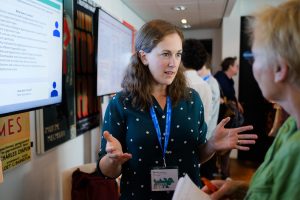
Making a material contribution to iPres 2019
(photo courtesy of iPres 2019: https://www.flickr.com/photos/ipres2019/48756130556/)
And that was largely because, in between those two conferences, I’d had an epiphany.
To explain, all of my jobs to date have been what you would describe as a ‘support service.’ In previous roles I have marketed a core service, written proposals for contracts providing a core service and – now I was working in digital preservation – I was communicating and raising awareness about digital preservation but not actually doing it myself. So, I’d never considered myself part of the communities, rather more peripheral to them.
However, in 2018 there began a series of conversations about iPres, community, welcome and inclusion and it dawned on me, that for digital preservation to work well it needs all sorts of people. And the contribution of every individual as part of the digital preservation community is valuable and should be valued equally.
Digital preservation needs new people to come and share different perspectives and innovations, it needs people who have been working in the field for a long time to provide their experiences, it needs people from all corners of the globe; it needs researchers, developers, IT scientists, training providers, archivists, librarians, records keepers and service providers; it needs people from large institutions and small ones, and it needs communicators (like me) to help raise awareness!
This was quite the revelation, but it provided me with the confidence to submit a Poster for iPres 2019 on advocating for digital preservation (incidentally, this went on to win the Best Poster Award helped by my inclusion of cats in the accompanying video!) and my sense of place within the community grew from there. And with that sense of place came a real appreciation for the community itself, what I could learn from everyone within it, and what I could contribute back.
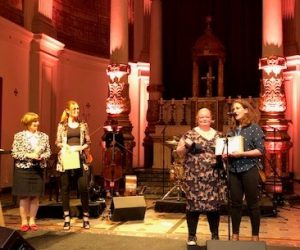
Collecting the Best Poster Award was a HUGE boost!
(Photo courtesy of Ben Saxton)
I would love as many people attending iPres 2022 as possible to come away from Glasgow in September with that same sense of community, and that feeling of belonging to it. Within the Programme Committee we have lots of ideas about helping make newcomers or those attending independently feel more at home at the conference, about providing outlets for creativity and discussion for speakers of different languages, and about making the physical and online spaces accessible to all delegates. But we’re always open to more ideas! Please do get in touch and let us know what would help optimise your experience of iPres 2022, you can reach me at sarah.middleton@dpconline.org.
The Earlybird Registration is now open, so whether you are new to iPres or an old hand, wherever you practice digital preservation and in whatever capacity, you are part of the iPres community and you are welcome. We look forward to seeing you there 😊
Sarah Middleton, Head of Advocacy & Community Engagement for the Digital Preservation Coalition
Introducing Glasgow: The Dear Green Place
It is an often shared fact that Glasgow’s name comes from the Gaelic “glas chu” which can be translated as “Dear Green Place”. While there is actually some debate amongst etymologists as to whether that translation is accurate, it is an apt description for the city. It meets (or is at least trying hard to meet) two meanings of the word green.
On the environmental side of things, many people will be aware that Glasgow was the host of the COP26 climate change conference in late 2021 and there are lots of reasons why it was chosen. In 2020 the city council published its Climate Emergency Implementation Plan which details 52 actions the city will take to become Carbon Neutral by 2030. These actions cover a broad spectrum of issues including communications, planning and housing, green jobs, community awareness and education, transportation, alternative energy sources, and more.
The same month Glasgow was named a “Global Green City” by the Global Forum for Human Settlements. The award, sponsored by the United Nations’ Environment Programme, seeks to highlight ‘prominent progress and valuable experience’ in search of greener and more sustainable cities. Glasgow scooped the award after recording high scores across wide ranging criteria including planning, transport, low carbon and energy efficiency, transportation, buildings, open spaces and the economy.
Glasgow is also a city held in high regard for the quality and diversity of vegan and sustainable food offerings. It is regularly voted one of the best cities in Europe for vegan dining, with lots of purely vegan, or vegan-friendly restaurants and cafés (more on these at a later date). For eating at home, there is a vibrant and growing community of businesses offering local and sustainable produce. The Locavore shops across Glasgow being an excellent example.
We’re hoping that iPres 2022 will live up to this green legacy, ensuring there are sustainability policies in place at our venues, aiming for carbon neutrality, and more.

Glasgow’s landscape is 32% green spaces
Now onto another meaning of the word green. Despite its industrial heritage, beyond the city centre Glasgow is a remarkably green city. In fact, Glasgow’s landscape is 32% green spaces, the second most in the UK (only surpassed by Edinburgh). And there are a rich variety of experiences within those green spaces.
To the east of the city centre, only 15 minutes from the iPres 2022 conference venue, there is appropriately named Glasgow Green. It is Glasgow’s oldest park, established in the 15th century when King James II granted the land to Bishop William Turnbull and the people of Glasgow. The 136 acres park has been used for many purposes over the years, but is often now used for large scale festivals and entertainment. It is also home to the Templeton Carpet Factory building mentioned in the previous blog post, as well as Glasgow’s most idiosyncratic museum, The People’s Palace.
Over in the West End, we can find parks born of the wealth of the industrial revolution during the Victorian era. There is the Botanic Gardens, offering exotic flora and river walks, Victoria Park with its large swan and duck pond and fossilised trees, and Kelvingrove Park, one of the most iconic spaces in Glasgow. Overlooked by the University of Glasgow and the Kelvingrove Museum, the park is home to bowling greens, a bandstand that offers open air concerts in the summer, and is connected by a river walkway to the Botanic Gardens.
But it is over the Clyde on the city’s South Side where some of the biggest and best parks can be found. Queen’s Park and Bellahouston Park are also both products of the Victorian period, Queen’s Park offering lovely walks and regular farmer’s markets reflecting the increasingly trendy neighbourhoods nearby, and Bellahouston has expansive open areas and is home to the “House of an Art Lover”. However, if you’re looking for a park that has it all, then you need to head to Pollok Country Park.

Pollock House in Glasgow
At 361 acres, Pollock Country Park is Glasgow’s largest park and has a wide array of activities within its boundaries. For art lovers there is the Burrell Collection, reopening before iPres after major refurbishments that have taken several years. It houses the eclectic art collection of shipping magnate William Burrell, gifted to the city in 1944. There is also the grand Pollok House, a National Trust for Scotland property with a fantastic collection of Spanish art. For those who like more athletic activities, there are orienteering courses and mountain bike trails, and at a slightly slower pace there are river walks, and walled and wildlife gardens to explore. If your time in Glasgow is limited, it also offers the opportunity to catch sight of some Highland cows!

Check the Highland cows!
At conferences, we often spend too much time in auditoriums and meeting rooms, so if you have a chance I encourage you to go out and enjoy Glasgow’s green spaces!
This blog was written for you by Sharon McMeekin, Head of Workforce Development at the Digital Preservation Coalition and member of the iPres 2022 Local Organizing Committee
Why I iPres by Tricia Patterson
My first time attending iPres was in the Fall of 2018 in Boston, Massachusetts, when I was just a few years out of graduate school. International conferences hold a certain awe for an early career professional who is teetering on the precipice of being “important” enough to qualify for registration and travel funding, but I had the advantage of being on home turf. And because MIT and Harvard co-hosted the conference that year, I was privileged to be invited onto the Organizing Team.
I was beyond anxious. Still relatively new to the field, I overcommitted myself for fear of missing professional opportunities (#FOMPO?), and I was stretched thin between the Organizing Team, co-teaching a workshop, and co-presenting a paper. Yet I felt superficially embedded into the fabric of the conference: deeply insecure amongst this tight-knit group of digital preservation experts that all seemed to be friends. I attempted to project a facade of confidence, but I was too afraid of the sound of my own voice in a room where some practitioners’ years in the field outranked my age.
One of many things iPres does well is offering a variety of core and ad hoc contribution genres. There are the usual papers, panels, posters, and receptions, but organizers over the years have expanded the portfolio to include “bake-offs,” game rooms, hackathons, and more. These options provide attendees with a variety of ways to engage with scholarship and projects – and perhaps more importantly, with each other.

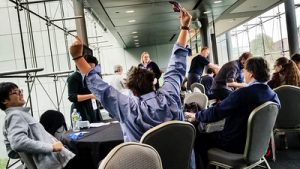
iPres 2018 GameRoom, photo credit: Kari Smith
On the second day of the conference, I settled down to play a digital preservation board game with strangers, worried that I would miss an easy trivia question and be exposed as a digipres charlatan. But as the rounds progressed, I realized: I knew this stuff. And honestly, everyone was enjoying the game too much to judge me if I didn’t. Later at a reception, shyly clinging to the few people I knew, I was emboldened to say hello to fellow game players from earlier that day.
In the span of that week, a subtle but significant transformation occurred. Getting to know colleagues from across the globe was like palliative care for my imposter syndrome. I had arrived, a debutante at the digital preservation ball! And beyond that, hearing people from different countries brainstorm about collective challenges and obstacles anchored my appreciation that we shared a common goal of communicating with the future.
In the years since, I haven’t attended iPres in person – it was too far, or a global pandemic happened. But the sense of fellowship seeded there has grown deeper. iPres itself has continued to evolve to cultivate that for others as well. After 2018, the iPres Working Group formed to review aspects of the conference like engagement and transparency (and they’ve done wonderful work towards this). Sometimes when I’m talking about “professional norms” with friends that are in different fields, I realize how fortunate I am to have chosen a professional community that prioritizes improving itself so it can foster belonging for everyone. And I can’t wait to reunite with that community in Glasgow.
Tricia Patterson
Senior Digital Preservation Specialist
Harvard Library, Harvard University
Introducing Glasgow: Our Architectural Heritage
In this month’s “Introducing Glasgow” blog post we’ll be taking a quick look at the city’s architectural heritage.

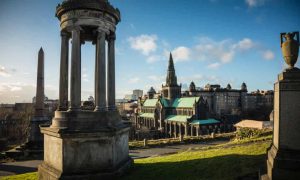 Glasgow was founded in the late 6th century and from then, through the Medieval period, the heart of the settlement was around the area that is now the High Street. Little remains of the city from that era beyond the 12th century Cathedral, dedicated to Glasgow’s patron saint, Saint Mungo, and the 15th century Provand’s Lordship. The cathedral is only 10 minutes walk from the iPres 2022 conference venue, perfect for a lunchtime visit. The Glasgow Necropolis also sits atop the nearby hill and is home to numerous grand monuments to Glaswegians-past and offers wonderful views of the city.
Glasgow was founded in the late 6th century and from then, through the Medieval period, the heart of the settlement was around the area that is now the High Street. Little remains of the city from that era beyond the 12th century Cathedral, dedicated to Glasgow’s patron saint, Saint Mungo, and the 15th century Provand’s Lordship. The cathedral is only 10 minutes walk from the iPres 2022 conference venue, perfect for a lunchtime visit. The Glasgow Necropolis also sits atop the nearby hill and is home to numerous grand monuments to Glaswegians-past and offers wonderful views of the city.
The aesthetic of Glasgow was truly established during the Victorian period, as the industrial revolution brought great wealth and prosperity to the city. The architecture was significantly influenced by two architects: the Neo-Classicism of Alexander “Greek” Thomson and the Art Noveau “Glasgow-Style” of Charles Rennie Mackintosh. Although there are some wonderfully idiosyncratic buildings from this period too (more on these later). The grand red and blond sandstone buildings of the city center, and their grid layout, has made Glasgow a prime filming location in recent years, as studios look for cheaper alternatives for cities like New York. Beyond the city center, much of Glasgow is dominated by post-war housing, built as the city continued to expand at pace.
One of my favorite things to do in any city I visit is to wander around, taking in the architecture, always remembering to “look up”. I’d definitely encourage you to do this in Glasgow, as the grandeur of the buildings isn’t always obvious at eye-level. But if you’d like some tips on architecture not to be missed, I’ve put together a list of some of my favorite buildings by area.
City Center
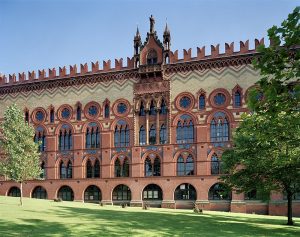
Starting out at the east end of the city center, we find one of my favorites amongst the idiosyncratic buildings I mentioned earlier, Templeton’s Carpet Factory. Built to demonstrate architectural opulence and resemble the Doge’s Palace in Venice, I find it wonderfully ludicrous that such an ornate facade was included on a building that housed a carpet factory. It is now home to offices and a small brewhouse and is about a 15 minute walk from the iPres 2022 conference venue. Nearby you’ll also find the People’s Palace and the Winter Gardens, but I’ll return to those in a future blog post.
Moving west through the city center we come to the City Chambers, home to the grand marble staircase I mentioned in last month’s blog post. Next is The Lighthouse, one of Charles Rennie Mackintosh’s first commissions and now Scotland’s Centre for Architecture and Design. This building houses a viewing tower with a unique aspect over the roofs of the city.

A short walk from the Lighthouse is Central Station, the busiest train station in Scotland. Normally a place to hurry through, it is well worth spending time taking in the building. There are tours available where you can see the vast storage arches that were once used to house goods, and the eerily preserved abandoned village of Grahamston that still exists below the station. One thing to look out for at Central Station is the 2 phases of construction of the glass roof, one designed by an architect and one by an engineer. Your challenge is to work out which is which!
 Heading north from Central Station, you can find one of Alexander “Greek” Thomson’s classically-styled buildings on Sauchiehall Street which now houses the Centre for Contemporary Arts. Sadly, the nearby Glasgow School of Art building, perhaps Charles Rennie Mackintosh’s most famous design, has twice been ravaged by fire in recent years.
Heading north from Central Station, you can find one of Alexander “Greek” Thomson’s classically-styled buildings on Sauchiehall Street which now houses the Centre for Contemporary Arts. Sadly, the nearby Glasgow School of Art building, perhaps Charles Rennie Mackintosh’s most famous design, has twice been ravaged by fire in recent years.
Southside
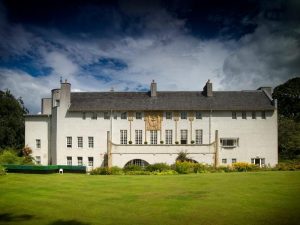
Thankfully, two excellent examples of Mackintosh’s designs can be found in the Southside of the city. The first is the Scotland Street School which now houses a museum covering education in Scotland through the decades (currently closed for renovations). The second is the House for an Art Lover, designed by Mackintosh in 1901 for an architectural contest, but not built until nearly 90 years later. It now houses exhibitions, event spaces, and offers scholarships and education to further interest in architecture and design.
Thomson’s most famous residential project can also be found in Glasgow’s Southside at Holmwood House, now a National Trust for Scotland property. The Grecian stylings used throughout the house provide, perhaps, the best example of his signature style that earned him the nickname “Greek”.
West End

Heading out towards the west of the city along the side of the river Clyde you will find the Scottish Event Campus, home to the iconic Clyde Auditorium. Lovingly referred to locally as “The Armadillo”, its shape was inspired by the Sydney Opera House. The relatively new Hydro concert venue is also included in the campus and is striking when lit at night (I like the rainbow option the best!) Both were designed by internationally renowned architects Foster + Partners.
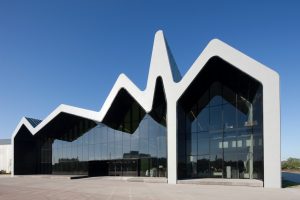 Further along the waterfront you will also find the Zaha Hadid designed Riverside Museum, completed just over a decade ago, which houses the city’s Transport collections. The shape of the building was designed so that it is not possible to appreciate its complete form from a single vantage point, and waves of the roof represent the city’s connection to the waterfront.
Further along the waterfront you will also find the Zaha Hadid designed Riverside Museum, completed just over a decade ago, which houses the city’s Transport collections. The shape of the building was designed so that it is not possible to appreciate its complete form from a single vantage point, and waves of the roof represent the city’s connection to the waterfront.

Finally, in the west end proper, you’ll find 3 of the most iconic structures in Glasgow: the Kelvingrove Art Gallery and Museum, the University of Glasgow, and Kibble Palace at the Botanic Gardens. Kelvingrove and the University sit on either side of the Kelvin river and a view of both is one most often used images on postcards from the city. Both were built in the late-19th century, and are quintessential representations of the wealth of that period. A grand red stone building designed in the Spanish Baroque style by Sir John W. Simpson, Kelvingrove was originally built as the Palace of Fine Arts for the Glasgow International Exhibition of 1901.
The main university building which stands atop the hill behind Kelvingrove, is formally named the Gilbert Scott building after its architect, Sir George Gilbert Scott (who also designed St Pancras station in London). A Gothic revival design, it is the 2nd largest of this style in the UK, after the Palaces of Westminster. The ancient pretense of its facade hides the, what was at the time, cutting-edge building method of an iron frame construction. Nowadays the building is warmly referred to by students of the University as “The Harry Potter Building”.
The last structure to mention is Kibble Palace in the Botanic Gardens. A huge wrought-iron framed greenhouse that is home to collections of orchids, tree ferns, and carnivorous plants, it is also put to a wide range of other uses. In recent years I’ve attended a wedding there, a production of Marlowe’s Richard II, and a light show called GlasGLOW. You’ve really not experienced the building until you’ve seen it with a huge disco ball and matching tunes!

We’ve reached the end of my whistle stop tour through some of Glasgow’s architectural history, but there’s plenty more to see in person. So make sure to come to iPres 2022 in September!
This blog was written for you by Sharon McMeekin, Head of Workforce Development at the Digital Preservation Coalition and member of the iPres 2022 Local Organizing Committee
Why I iPres by Tracy Seneca

I’ll admit from the start that as I prepare this post about “Why I iPRES”, I have a goal. And that is to persuade anyone who is on the fence – asking yourself “Should I come?” “Should I submit a proposal?” You should. Particularly if your concern is that you’re coming from a smaller organization, or from an organization that is only beginning or even hoping to begin working in digital preservation. Yes, iPRES is the place for cutting-edge research and development in digital preservation. But it is also very much a place where you can find your bearings in this field, find others who are in your same situation, and find guidance and inspiration for the work ahead. William Kilbride conveyed this message beautifully in the first “Why I iPRES” post, but it bears repeating.
I first attended iPRES in 2005 and have participated a number of times since. In those years, I’ve worked for two quite different organizations, the California Digital Library (CDL) and the University of Illinois at Chicago (UIC). At the California Digital Library I worked in web archiving, and iPRES not only directly addressed my work, but also provided grounding in broader issues of digital preservation. I joined UIC to come home to my beloved city of Chicago and to support digital access to UIC’s remarkable Chicago history collections. At the time I arrived, UIC had amassed terabytes of digital material (~60 TB today) but had nothing beyond simple file servers to manage and store the master copies. An early analysis of our digital assets using the NDSA Levels of Digital Preservation rubric showed us at a solid “level zero” in many respects. Establishing the first comprehensive preservation and access repository at UIC has been the focus of our work for the last few years.
CDL and UIC are two very different organizations. They’re in very different positions vis-a-vis digital preservation. But iPRES has remained a valuable resource for me in both places. For example, Shigeo Sugimoto of the University Tsukuba has been a frequent contributor and active member of the iPRES community. At CDL, the work of Professor Sugimoto and others at the University of Tsukuba was an inspiration for the Bag-It specification, developed by the Library of Congress and CDL to transfer web archive data between institutions. Years later, we used that same specification at UIC to participate in the Digital Preservation Network (DPN) initiative.
In 2014 iPRES featured the work of Stacey Erdman, Jaime Schumacher and others in the Digital POWRR Project. Founded in 2012 and based out of Northern Illinois University, Digital POWRR “investigated, evaluated, and recommended scalable, sustainable digital preservation solutions for libraries with smaller amounts of data and/or fewer resources”. At iPRES 2018 and again in 2021, Erdman worked with Paul Wheatley and others to support a “COPTR-edit-a-thon”. COPTR, or the Community Owned digital Preservation Tool Registry, is exactly the sort of project that serves organizations that don’t already have access to a robust digital preservation infrastructure.
So whether it will be the conference themes of Innovation or Community that inspire you, iPRES 2022 will have something to offer. And I’m very much looking forward to meeting the city of Glasgow!
Tracy Seneca
Head, Digital Programs & Services
University of Illinois, Chicago Library
Introducing Glasgow: a New Blog Series and 10 Fun Facts
There were lots of reasons to be excited when the DPC was chosen to host iPres 2022 in Glasgow. Perhaps the most important is that it coincides with the 20th Anniversary of the Coalition, giving us the perfect opportunity to include the whole digital preservation community in our celebrations.
But on a personal level, I was excited that I’d get to share my beloved hometown with all the wonderful digital preservation friends and colleagues I’ve met in my fifteen years of working in the field. It’s a city that keeps drawing me back: I was born nearby, and while I’ve moved away to other parts of Scotland three times, I’ve always found myself returning to Glasgow after not too long. It’s the city where I completed all three of my degrees, where I bought my first home, where I adopted my wee rescue doggo, Pretzel, and where I’ve worked with the DPC for the past 10 years.
It’s by no means perfect (what city is?) but it’s a place with real heart and soul, well known for the warm welcome extended to visitors. There’s a reason why the city’s brand is “People Make Glasgow”. Mentions of that warm welcome appeared again and again in the tweets from the recent COP26 climate conference. In fact, one CNN reporter loved her time in the city so much she’s been adopted as a new Scot! Check out Ika’s tweets here. Her story is a perfect example of a well-known meme about the flowchart for being Scottish….
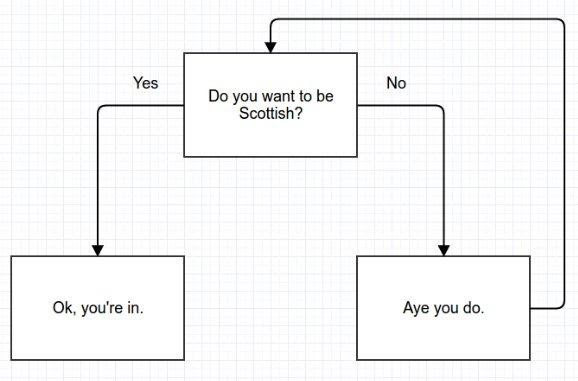
Back to the purpose of this blog post, when we started thinking about comms for iPres 2022, I was keen to be involved in sharing my love of Glasgow and encouraging the digital preservation community to come and join us in the city. I had lots of ideas about what I could do, and you’ll be seeing a couple more of those ideas become reality throughout the year, but one proposal was a monthly series of blog posts showcasing some of my favourite things about Glasgow.
So here we are, this post serves as the introduction to that series. Over the months between now and September I’ll share with you some of my favourite things to see and do, insider tips on where to find the best food and drink, and bits and pieces of the rich history of the city. I actually thought about starting off with an abridged history of Glasgow but couldn’t decide what to leave out to make sure the blog post didn’t end up as a novel! So instead, I’m going to leave you with 10 fun facts about Glasgow, and I’ll be back in February with more….
1. There are trees in Glasgow older than dinosaurs – Fossil Grove in Victoria Park has 11 fossilised tree stumps that are over 330 million years old.
2. The City Chambers has more marble than the Vatican – It cost £578,232 to build the Chambers in 1889, the equivalent of more than £40 million today. The Carrera marble was imported from Italy, and the opulent main staircase has been a stand-in for the Vatican on film and TV. A mini-version of the Statue of Liberty is also among the adornments of the City Chambers.
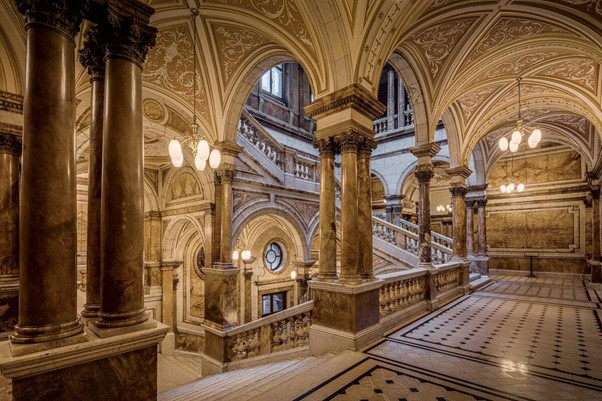
3. Glasgow’s Subway is the third-oldest underground train system in the world – Nicknamed the “Clockwork Orange”, the subway system opened in 1896. It is a simple loop with 15 stations, with trains running clockwise and anti-clockwise. There is a local tradition of pub crawls round the stops, but (experience tells me) it’s not for the faint hearted!
4. It’s claimed that Glasgow is home to the remains of St Valentine – The supposed remains, housed in a small wooden box at the Church of Blessed St John Duns Scotus, are part of a set of relics donated to the Franciscan church in 1868.
5. The first international football (soccer) game was played in Glasgow – In 1872 the first international football match took place between England and Scotland at the West of Scotland Cricket Ground in Partick.
6. Stan Laurel (of Laurel and Hardy fame) began his career at one of the city’s theatres – He made his stage debut at the Panopticon Theatre, in Trongate, just before his 16th birthday in 1906. It was there he developed many of his comedy trademarks, including adopting his iconic bowler hat. The Panopticon remains open and is now the world’s oldest surviving music hall.
7. The Hunterian Museum at the University of Glasgow is the oldest museum in Scotland – The university itself is the 4th oldest in the UK but is also home to the oldest museum in Scotland. Opening in 1807, the museum was built to house the collections of anatomist and physician, William Hunter.
8. One of the city’s pubs is home to the longest bar in Europe – The Victorian-era Horseshoe Bar in Drury Street boasts the longest pub bar in Europe at an impressive 104 feet and 3 inches.
9. The city also boasts Europe’s largest public reference library – Built thanks to bequests from local industrialists and philanthropists, The Mitchell Library is the central hub of the city council’s library services.
10. One of Glasgow’s most iconic landmarks is an equestrian statue with a traffic cone on the rider’s head – Despite the best efforts of the local council, the statue of the Duke of Wellington in Royal Exchange Square is rarely to be found without (at least one) traffic cone on his head. It was listed in a 2011 Lonely Planet Guide as “one of the top 10 most bizarre monuments on earth”. Sometimes his horse even gets to join in too …

This blog was written for you by Sharon McMeekin, Head of Workforce Development at the Digital Preservation Coalition and member of the iPres 2022 Local Organizing Committee.
Why I iPres by William Kilbride
DPC is hosting iPres 2022. I have mentioned this very many times and no one should be surprised by the news. But I have a new variation for you. I have just stepped back into work after a winter break and pinned a new calendar to the wall. It tells me that DPC is hosting iPres this year. There is more of a tremble in my voice when I phrase it like that.
Preparations are going well (at the time of writing at least). Over the next few months – from now until the proceedings are published – we’ll maintain this blog to keep you posted on plans and highlights as they emerge. We will also use the blog to build momentum and create a space for reflection and debate. We’ve invited contributions from the programme committee to help explore the main conference themes; and we’ve invited some regulars to share highlights (and perhaps some low points) of iPres over the years. We want to know what keeps them coming. We’ve also lined up a group of first-time participants and some not-yet attendees to share their experiences and expectations too. Our hope is to lay a solid foundation for discussion around the conference themes. Perhaps more importantly, we hope to articulate the enthusiasm of the community and the welcome that comes with it. Ceud mìle fàilte – a hundred thousand welcomes – as we said at the handover in Beijng in October. It’s a big target but we’re nothing if not ambitious.
I cannot ask others to reflect on iPres and its themes without attempting an answer of my own. For me this comes in two parts.
I should start with the twentieth anniversary of the DPC. The anniversary is the simple logic for investing our time and energy in iPres this year: inviting the whole world to our home city to join us as we celebrate twenty years together. The DPC’s practical origins can in fact be traced to a conference hall. A small group of specialists met at ‘Preservation 2000’ conference in December of that year to discuss and debate their emerging needs. Lynne Brindley opened the conference with a keynote outlining the shared challenges that existed, the research that was already in hand, and the need for more collaboration between researchers and more involvement with the wider community of ‘authors, publishers and other digital content creators, funding agencies, senior administrators, hardware and software manufacturers, and so on.’ That call led directly to the DPC taking legal form a year later. Since the DPC was called into existence at a conference there’s a pleasing logic to mark twenty years with a conference of our own.
Memories of that event help me frame a more rounded answer to the ‘Why I iPres?’ There couldn’t have been many more than 100 people, but it seemed like the whole of digital preservation was there, with representatives from around the world, each on their way to developing what would become digital preservation strategies and infrastructures.
I wouldn’t want you to think I belonged in this esteemed company. At the time I was working at the Archaeology Data Service, just up the road from the conference venue in York. Although ADS had a reasonable claim to digital preservation expertise, having ingested its first full digital archives a year earlier, my attendance was a happy geographical coincidence. Our budget wouldn’t have stretched to travel or accommodation.
It was a real eye opener for me to discover other people from so many places with interest in the topic but, as an archaeologist at a library conference, I could not have been more of an impostor. Even so I remember chatting cheerfully with Paul Wheatley about the CAMiLEON project and his thoughts about emulation over migration. I think I met Kevin Ashley, Helen Shenton, Oya Rieger and Cal Lee there for the first time (though it’s worth checking with them). I remember sharing a coffee with Maggie Jones and Neil Beagrie: I knew them already so was bold enough to chat with them. I also remember chatting with Michael Day who was then with UKOLN and whom I knew through a network of mutual colleagues and projects. I recall meeting Marcel Ras, also an archaeologist by training, who like me had also achieved the significant career goal of a warm dry job indoors.
This experience goes some way to explaining ‘why I iPres?’ I have benefitted hugely from the relationships that are kicked off and renewed at conferences like this. I came to Preservation 2000 almost by accident, but I honestly don’t think I would be doing the job I do today without the advice and friendship of many of the people I met there. That’s not to say these have been the only or even the most important influences: but if you’re doing digital preservation alone you’re not doing it right.
I’ve been immensely privileged to participate in 8 iPres conferences – 9 if you include #WeMissIpres in 2020. I am sure others will have better examples of papers that have inspired or surprised them but I want to emphasize the welcome and approachability of iPres. It’s not all po-faced. I remember the time I inadvertently dropped the USB stick with my presentation directly into an air-conditioning duct in a lecture hall in Lisbon and had to rewrite the presentation more or less from notes (Do as I say, not as I do). I remember getting so helplessly lost in Bern that, if house prices had been affordable, I might have been forced to live there forever. I was rescued by a genial family of traditional swiss toy makers who, strangely enough, were heading to the same conference venue to exhibit their wares. I recall in chairing session 404 in Boston (a number to conjure with at a conference about broken links). It was a large space split in two with a moveable partition. I can’t remember the detail of the session, but I do remember apologizing to the session on the other side of the partition who couldn’t concentrate on format validation because of the raucous laughter from our side.
I don’t want you to think iPres is some kind of oddly themed screwball comedy. We have put a lot of work into the conference themes and the call for contributions. Proposals will be carefully scrutinised and the best quality ones will be selected. As I write this, the Programme Committee is debating an immensely impressive list of keynotes. We have a serious purpose and will ensure that we give the best possible account of emerging theory and practice in digital preservation in 2022. But more than anything it is the community who make iPres for me. Fundamentally, digital preservation is done for people and done by people and that’s why I am looking forward to reading what others will say in this blogpost series.
To adapt a local slogan: people make digital preservation; and people will be the making of iPres 2022.
William Kilbride
Executive Director of the Digital Preservation Coalition
and Chair of the iPres 2022 Organizing Committee
iPres Hand Over
中文翻译如下
Professor Zhang, distinguished guests, colleagues and friends, it is a privilege and a pleasure to join you this evening at the closing ceremony for iPres 2021.
In a few moments I will have the honour of inviting you to the 18th iPres Conference in September 2022.
But first I wish to take a moment to thank you and your many colleagues, sponsors and friends.
Organizing a conference is a significant undertaking, and organizing an international event adds to the complexity. But the planning of iPres 2021 has been more demanding than any iPres before, and hopefully ever. It has been significantly more work than you could have imagined when you first offered to host us.
Here’s the paradox of the last two years: at a time of isolation and distancing, we have never had so much in common; at a time when digital infrastructures have become central to our lives, our opportunities to plan and reflect on digital continuity have been subdued; at a time when we have learned so much, all that new-found, hard-won knowledge has gone unshared.
We have missed iPres. And you have brought us together again.
So I cannot progress until I say how immensely grateful I am – we all are – for the patience, resolution, creativity, cheerfulness and compassion which have encouraged and enabled our meetings this week. I also want to recognise and thank the National Science and Technology Library and the Chinese Academy of Sciences for their leadership and support in delivering iPres 2021.
And so now to my task. To invite you and colleagues to meet in Glasgow next year.
Let me first put Glasgow on the map for you. The easiest way to find Glasgow on a map, is to find the top left-hand corner of the Roman Empire. For around 20 years the Romans added southern Scotland to their Empire. I speak today only a few hundred metres from the wall that the Emperor Antonine built to protect the province of Caledonia.
Imagine us therefore, silk road travellers, packing for an arduous journey on the ancient routes west of Beijing, to the farthest extreme of the farthest empire. Literally the end of the world.
And here’s a thing. We need an ancient historian to help us, but it’s just possible that the same Antonine who built the wall north of Glasgow, is the same Antonine who sent the first diplomatic mission from Rome to China and was welcomed by Emperor Huan of Han in 166 AD. Huan was the grandson of emperor Zhang by the way clearly a name to conjure with.
So, as those weary travellers would have done, I bring greetings from the edge of the world. There are a few practical details I would like to share.
Firstly, we want to consult the community about the conference themes as well as the different conference activities. That’s an immediate invitation to you all: follow the link to the website and you’ll find the consultation there. We’ll keep this open for three weeks, and the programme committee will then discuss the comments received.
I’d like to introduce the Programme Committee. I am grateful to these many colleagues who have generously offered to help us form the program.
You will notice that the committee is larger than in previous years. That’s for two reasons. Firstly the digital preservation community is growing and we wanted to reflect that. Also, the DPC is strongly committed to the next generation of leaders. So we have deliberately made the committee about 50% larger, explicitly including a group who have not previously organized a global conference. They will be our hosts and leaders in the years ahead But that’s not all. We’re aware of our own limitations and, with a firm commitment to welcome and inclusion, we have an open invitation to anyone who might be interested in joining the programme committee to put your name forward.
There is a small local organizing committee and a professional conference organizer of course. They are accountable to the DPC’s wider membership through Tim Keefe and Kate Murray who sit on the DPC’s Executive Board as well as the Programme Committee.
Legacy is an important theme for us. We want iPres 2022 to make a difference locally, and so we are in the process of adding a third group to help our work. iPres 2022 will experiment with the establishment of a ‘Legacy Committee’ to ensure that digital preservation practice locally, in Scotland and across Europe can show some lasting benefit from our efforts.
Here are our key dates:
- We launch the conference website today, and there you will find the link to participate in the Community Consultation.
- The call for contributions will open on 1st December and close on 8th March. By the way, we’re encouraging a hard deadline so please don’t make be expecting that deadline to be extended.
- Early bird registration opens 16th March, then full registration on 1st August
- Indicative Programme will be launched 17th June
Here is our provisional programme:
- Monday will involve workshops and tutorials
- Tuesday, Wednesday and Thursday will be main conference sessions with three keynotes
- Friday will be professional visits,
We know there will be delegates who will want to join us online, so we are also thinking about adding:
- ‘Sunrise sessions’ for colleague joining remotely from time zones east of Glasgow
- ‘Late sessions’ for colleagues joining from the Americas
- Virtual visits and an online only strand allowing remote delegates to participate on an equal footing
Our social programme will include a welcome reception in Glasgow’s City Chambers. Also, because this is our 20th anniversary year, the conference dinner will double as the DPC’s 20th Birthday party, and treble as the presentation of the 2022 Digital Preservation Awards.
Our conference venue is a modern, purpose-built facility in the centre of the city. I won’t say much about it other than there are plug sockets at every seat in the main auditorium. Imagine.
So all that it remains for me to do is to promise you a hundred thousand welcomes to iPres 2022.
Robert Burns would have said it better: There’s a hand my trusty friend and give me a hand o’ thine. We’ll take a cup of kindness yet for Auld lang syne’
Mention of Burns reminds me that I have a gift for you.
Glasgow is designated by UNESCO as a city of music. So, while we are unable to travel or meet in person, we can share this gift with you virtually.
We’ve assembled a playlist of songs and music associated with Scotland on Spotify. You’ll find the link to this on the conference website too. We hope it will keep you company and bring good cheer as you work on your proposals and set off on your journey.
This is a gift we can share with you easily in an online environment. It’s a gift you can share with us in return. We’ve opened the play list for your own suggestions and additions. We’ll share a bit of Scotland with you and in return we invite you to share a bit of your home with us.
Professor Zhang, distinguished guests, ladies gentlemen, colleagues and friends, reflecting on all that has gone before, considering all that lies ahead, my thanks and my hope, my duty my mission and my invitation, my message from one edge of the world to the rest: all of these can be summarized:
Let’s come together again in Glasgow in 2022
Let digits flourish
And let iPres flourish
William Kilbride
Executive Director of the Digital Preservation Coalition
and Chair of the iPres 2022 Organizing Committee
______________________________________
张教授、各位尊敬的来宾、同事和朋友们,很荣幸今晚能和大家一起出席 iPres 2021 的闭幕式。
稍后,我将有幸邀请您参加将于2022年9月举行的第18届iPres会议。
但是,在此之前,我想借此机会向您和您的诸位同事、赞助商和朋友们致以谢意。
组织一场会议是一项艰巨的任务,而组织一场国际会议更是平添了各种复杂性。不仅如此,本届iPres 2021的组织工作比以往任何一届会议都更繁重,希望这样的特例未来不会再重演。相信您当年答应承办iPres的时候,也未曾料到需要花费如此大的心血。
在过去的两年中,我们面临着几个自相矛盾的事实:尽管我们不得不与他人疏远,却发现了彼此之间前所未有的共同之处;当数字基础设施成为我们生活的中心时,我们规划和反思数字连续性的机会反而减少了;在我们行业知识锐增之际,这些来之不易的新知识却得不到分享。
我们怀念 iPres。是你们让大家终于又走到了一起。
因此,我必须首先在此由衷的道一声感谢——相信我可以代表在座的所有人——是你们的耐心、决心、创造力、开朗和爱心让本周的会议得以成功举行。
同时,我还要认可和感谢国家科技图书文献中心和中国科学院在举办 iPres 2021 方面的领导和支持。
好了,言归正传。我此次的任务是要诚挚地邀请您和同事们明年在格拉斯哥见面。
首先,让我们确定一下格拉斯哥的方位。
要想在地图上找到格拉斯哥,最简单的方法是先找到罗马帝国的左上角。罗马帝国统治苏格兰南部长达20年左右。安东尼皇帝为保护加勒多尼亚省而建造的城墙距我所在之地只有几百米的距离。
因此,想象一下,我们是即将踏上丝绸之路的旅行者,背着行囊从北京出发向西,沿着这条古老的路线,不辞辛苦,向着那最遥远的帝国的最远端前进。称其为世界的尽头并不为过。
尽管没有经过严谨的历史考证,但是我们可以猜测,那位在格拉斯哥以北建造城墙的安东尼,可能就是在公元166年派遣第一个罗马外交使团到中国并受到汉桓帝接见的安东尼。
所以,与那些疲惫的旅行者所肩负的使命一样,我向各位致以来自世界尽头的问候。
同时,我还带来了一些实用信息。
首先,我们想就会议主题以及不同的会议活动咨询社群意见。我们鼓励所有人的积极参与:请点击网站链接,参与咨询。该咨询的开放周期为三周,然后议程委员会将就收到的意见进行讨论。
请允许我介绍一下议程委员会。首先,我要向那些参与制定议程的同事们的的慷慨奉献表示感谢。
您会注意到本届议程委员会的人数要多于往年。原因有二。第一,数字信息保存社群在成长,我们想反映这一点。第二,DPC致力于支持下一代领导人。所以,我们刻意将委员会人数扩大了约 50%,专门邀请了一批没有全球会议组织经验的个人参与。他们将在未来几年成为我们的东道主和领导者。
我们还不止于此。在意识到自身局限性的同时,我们坚定地致力于欢迎和包容,因此,我们公开邀请任何有兴趣加入议程委员会的个人报名参加。
当然,我们还有小型的地方组织委员会和专业的会议组织者参与相关工作。他们向DPC执行理事会和议程委员会的成员Tim Keefe和Kate Murray汇报工作,受DPC全体会员的监督。
遗产对我们来说是一个重要的主题。我们希望 iPres 2022 在当地能有所作为,因此正在组建第三个小组来协助我们的工作。iPres 2022 将成立一个“遗产委员会”,该尝试旨在确保当地——苏格兰和整个欧洲的数字信息保存实践可以通过我们的努力获得一些持久的益处。
以下是该届会议的关键日期:
- 会议网站已于今日启动,上面有参与社群咨询的链接。
- 征稿将于12月1日开始,并于3月8日结束。顺便说一下,我们鼓励严格遵守截止日期,所以请不要期待截止日期被延长。
- 早鸟注册将于3月16日开放,然后在8月1日开放正式注册
- 指示性议程将于6月17日发布
以下是会议的临时议程:
- 星期一是讲习班和辅导班
- 周二、周三和周四是主要会议以及三个主旨演讲
- 周五是专业参观
考虑到可能有代表希望以线上形式参加会议,我们目前正在计划增加:
- “日出会议” – 供位于格拉斯哥以东时区的同事们远程加入
- “晚间会议” – 供位于美洲的同事们参加
- 虚拟参观和完全线上环节,让远程参会的代表可以平等参与
会议的社交活动将包括在格拉斯哥市政厅举行的欢迎招待会。此外,鉴于该届会议恰逢DPC的20周年纪念,届时的会议晚宴将摇身成为DPC的20周年纪念庆祝派对,同时也是2022年数字信息保护奖的颁奖典礼现场。
会议场地为位于市中心的现代化专用设施。关于会场的设施我就不多说了,就透露一点内幕,大礼堂的每个座位都有自己的专用插座。留给你们自己去想象吧。
该说的都说了,最后,我谨代表iPres 2022向您表示万分诚挚的欢迎。
借用苏格兰诗人罗伯特·伯恩斯的诗句可能更为贴切:让我们亲密挽着手,情谊永不相忘。
让我们来举杯畅饮,友谊地久天长。 提到伯恩斯让我想起我有一份礼物要送给大家。
格拉斯哥被联合国教科文组织指定为音乐之城。因此,虽然我们无法亲自到访或见面,但我们可以通过虚拟方式将这份礼物送给大家。
我们收集了与苏格兰有渊源的歌曲和音乐,并且在Spotify上创建了一份播放列表。您可以在我们的会议网站上找到该份播放列表。我们希望这些优美的旋律能够在您工作时带给您愉悦,在您旅行时成为您的伴侣。
这是一份我们通过在线技术送上的礼物,也是一份您可以回赠的礼物。我们将该播放列表设为可编辑状态,您可以建议和添加新的曲目。我们为您奉上苏格兰的一丝“婀娜”,也邀请各位分享自己家乡的一缕“曼妙”。
张教授,各位尊敬的来宾,女士们,先生们,同事和朋友们,回顾过去,展望未来,我致以的谢意,我寄予的希望,我肩负的职责,我担当的使命,我送上的邀请,以及来自世界尽头的问候:所有这一切化成一句话:
2022年让我们在格拉斯哥再相聚
让数据蓬勃发展
让iPres再铸辉煌
Blog